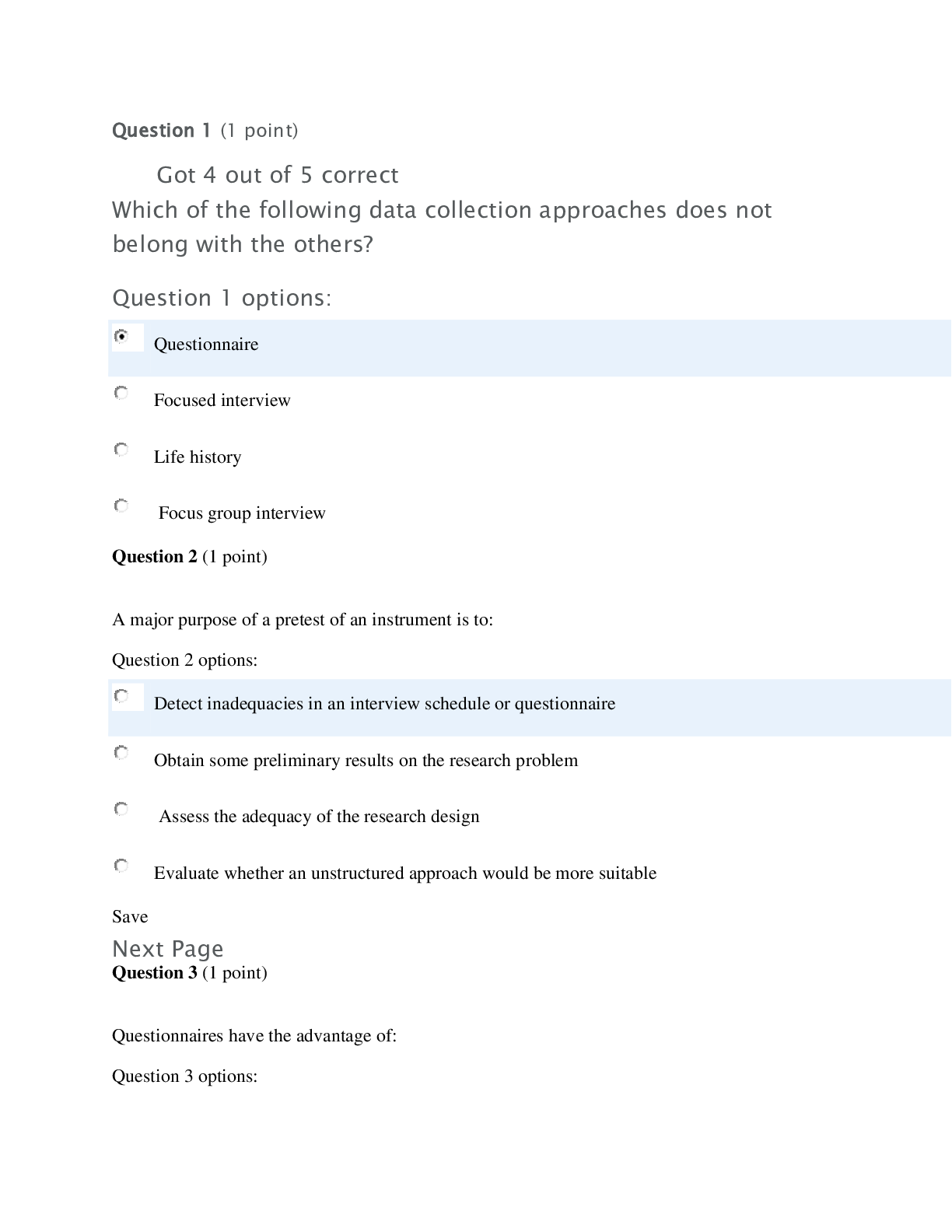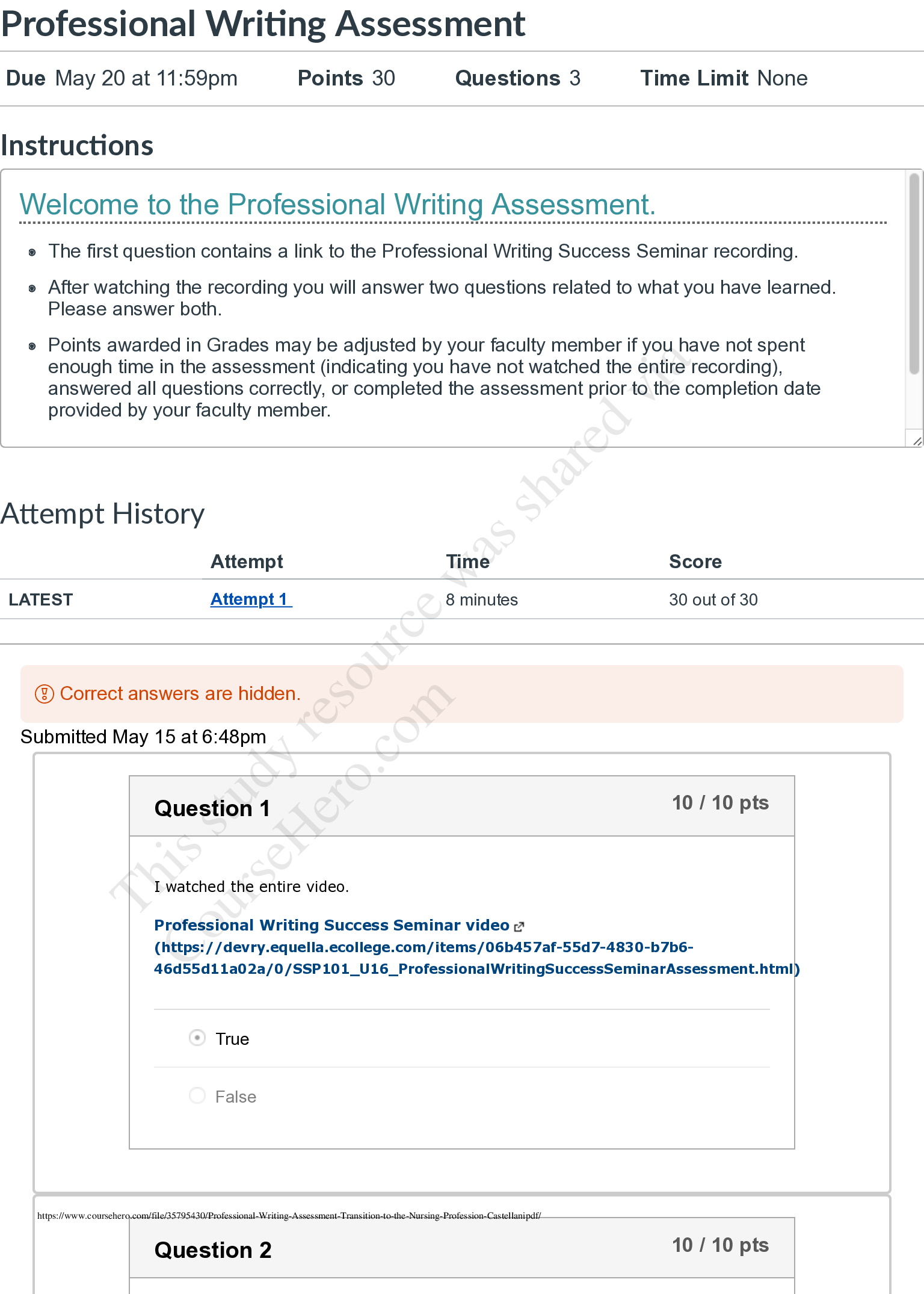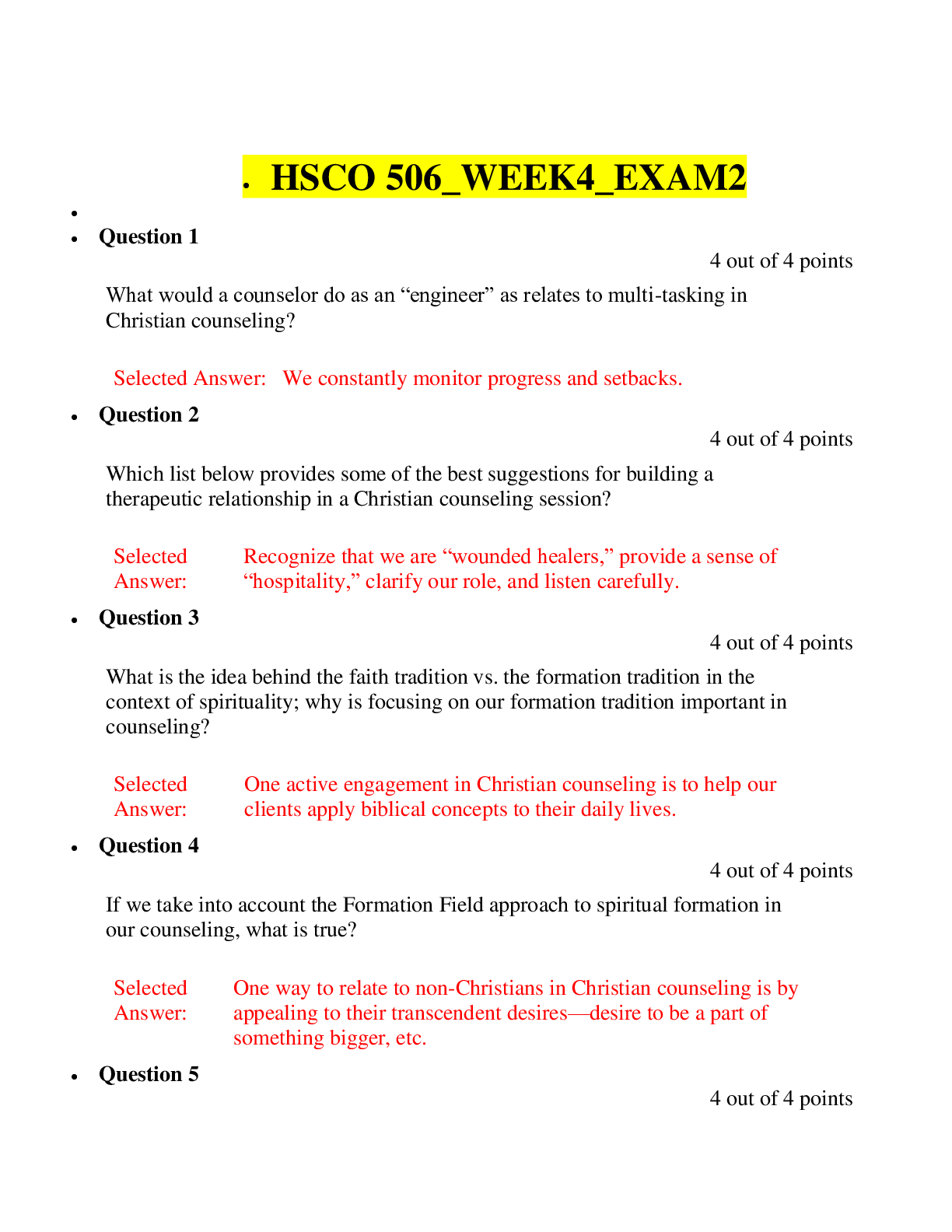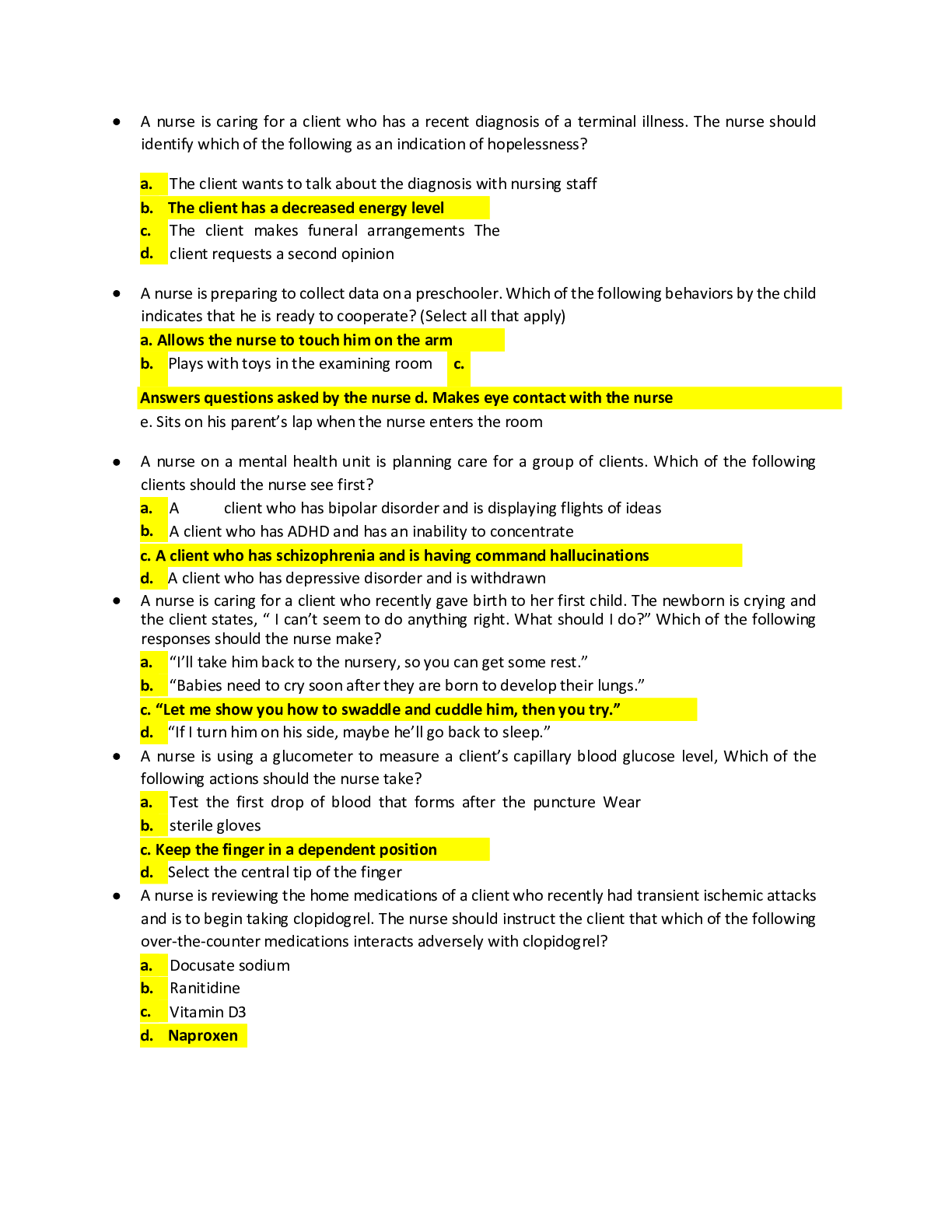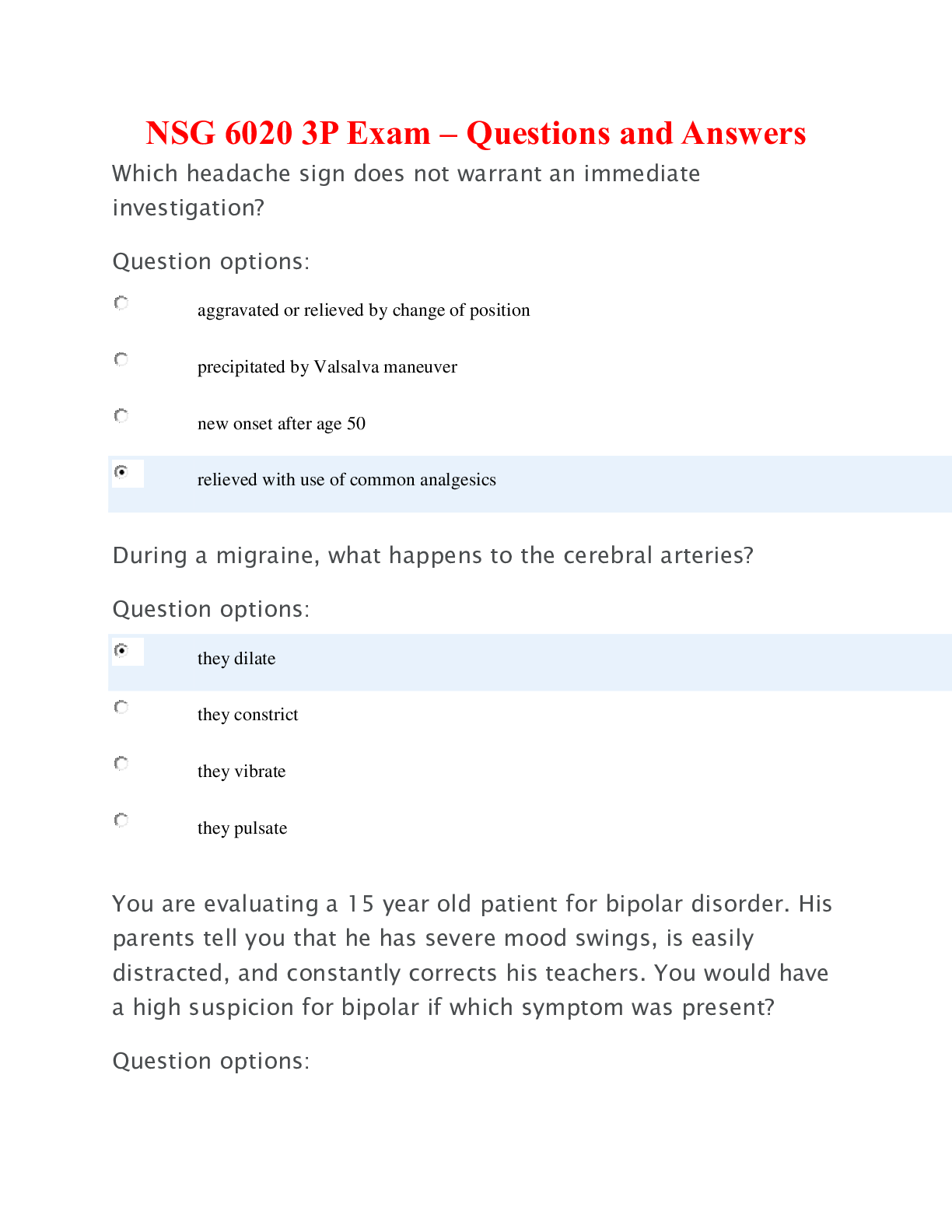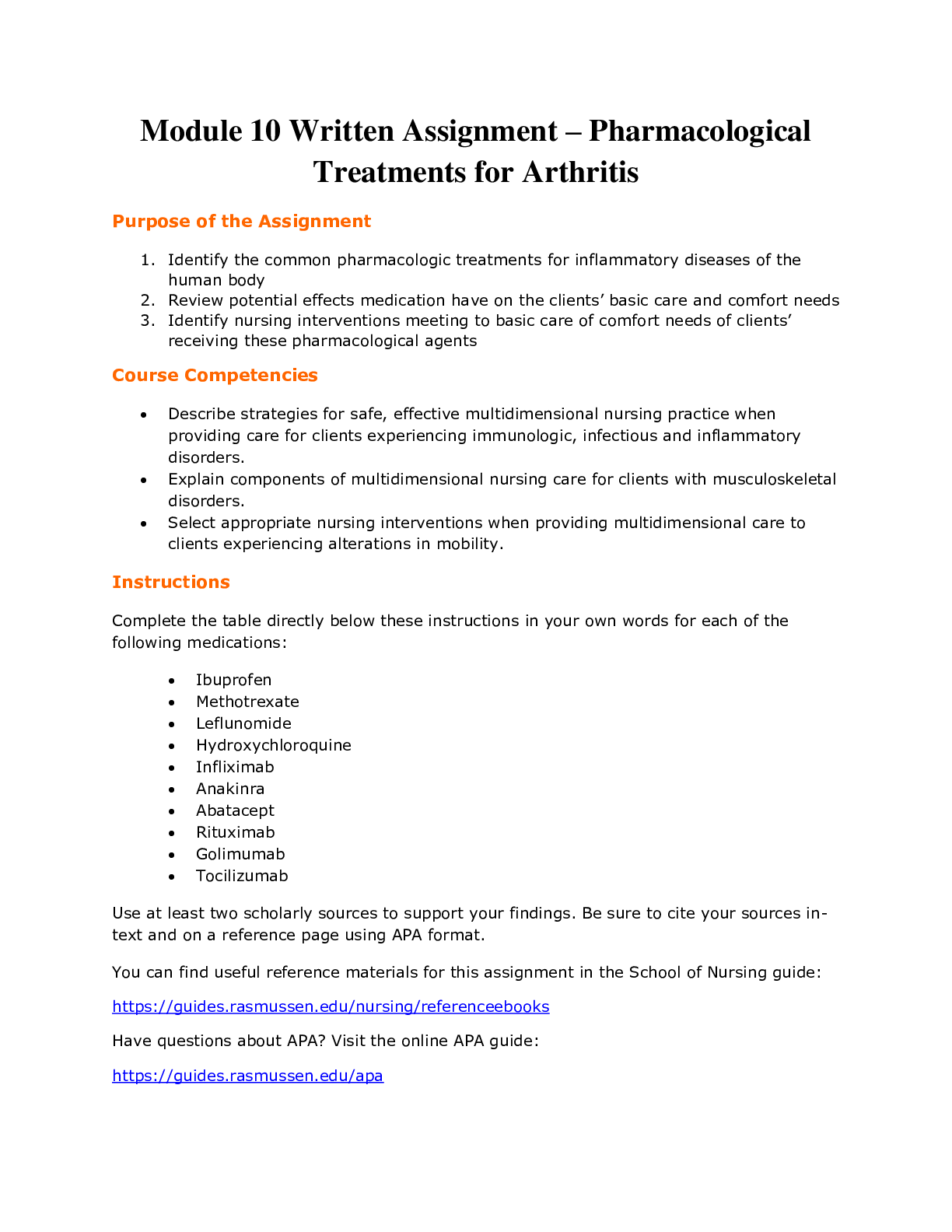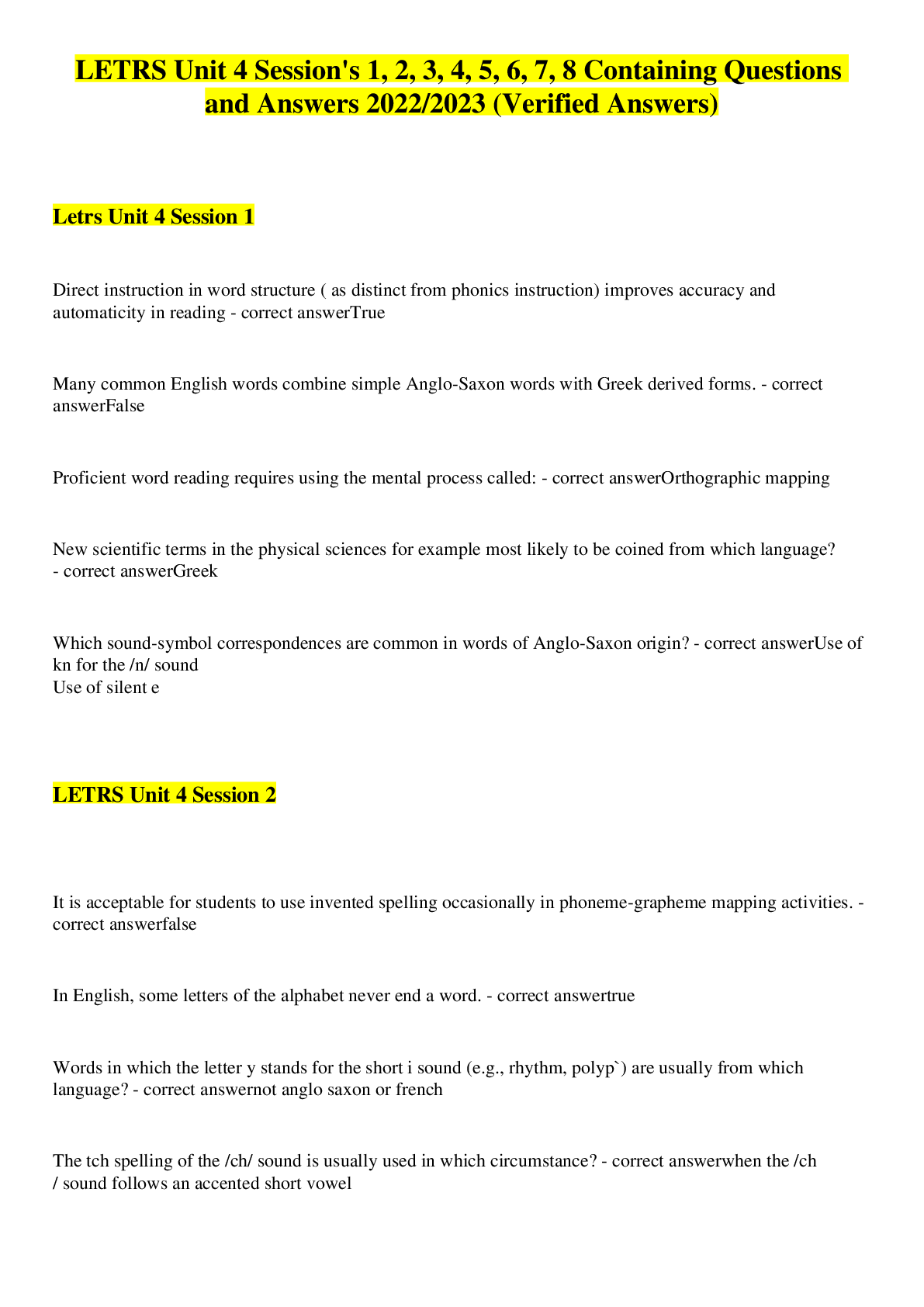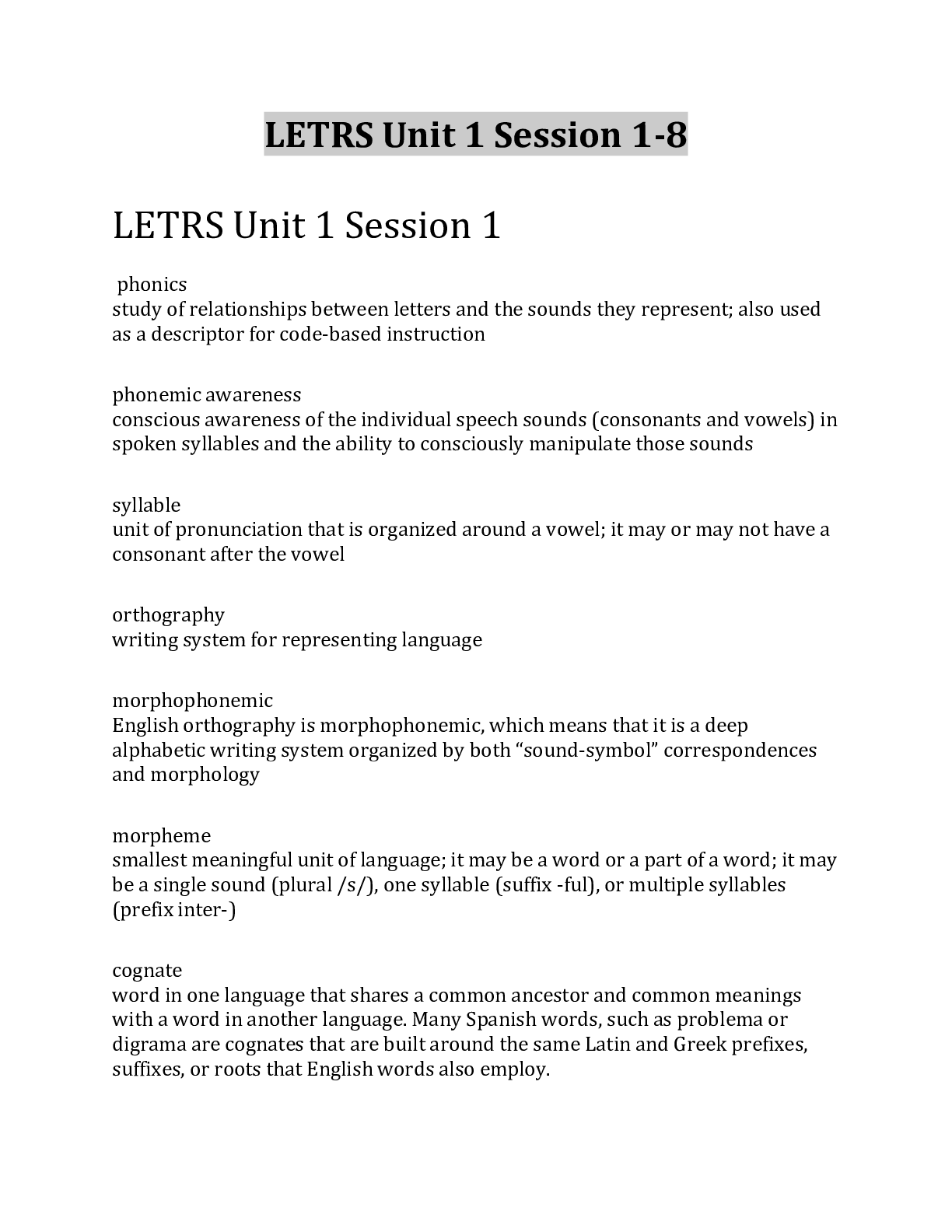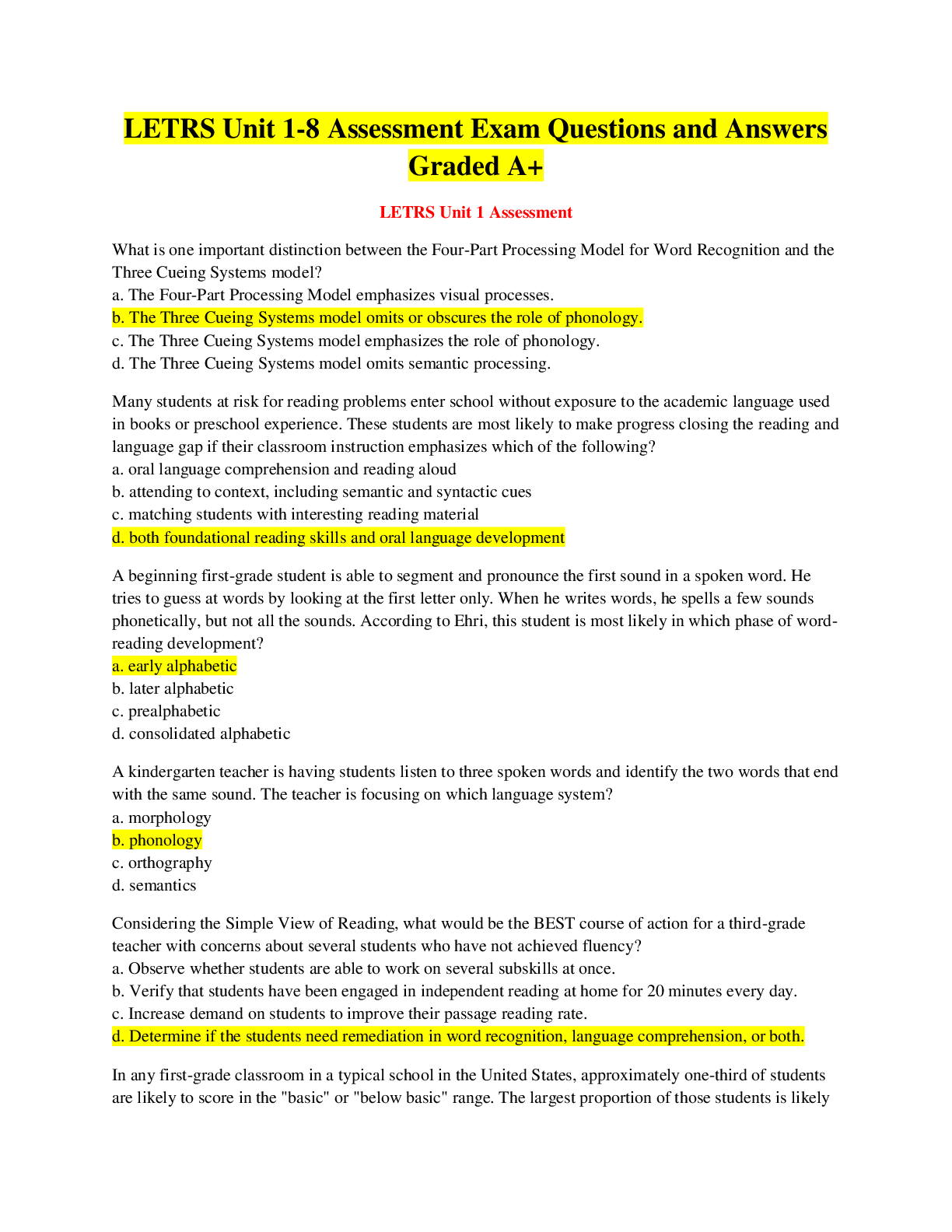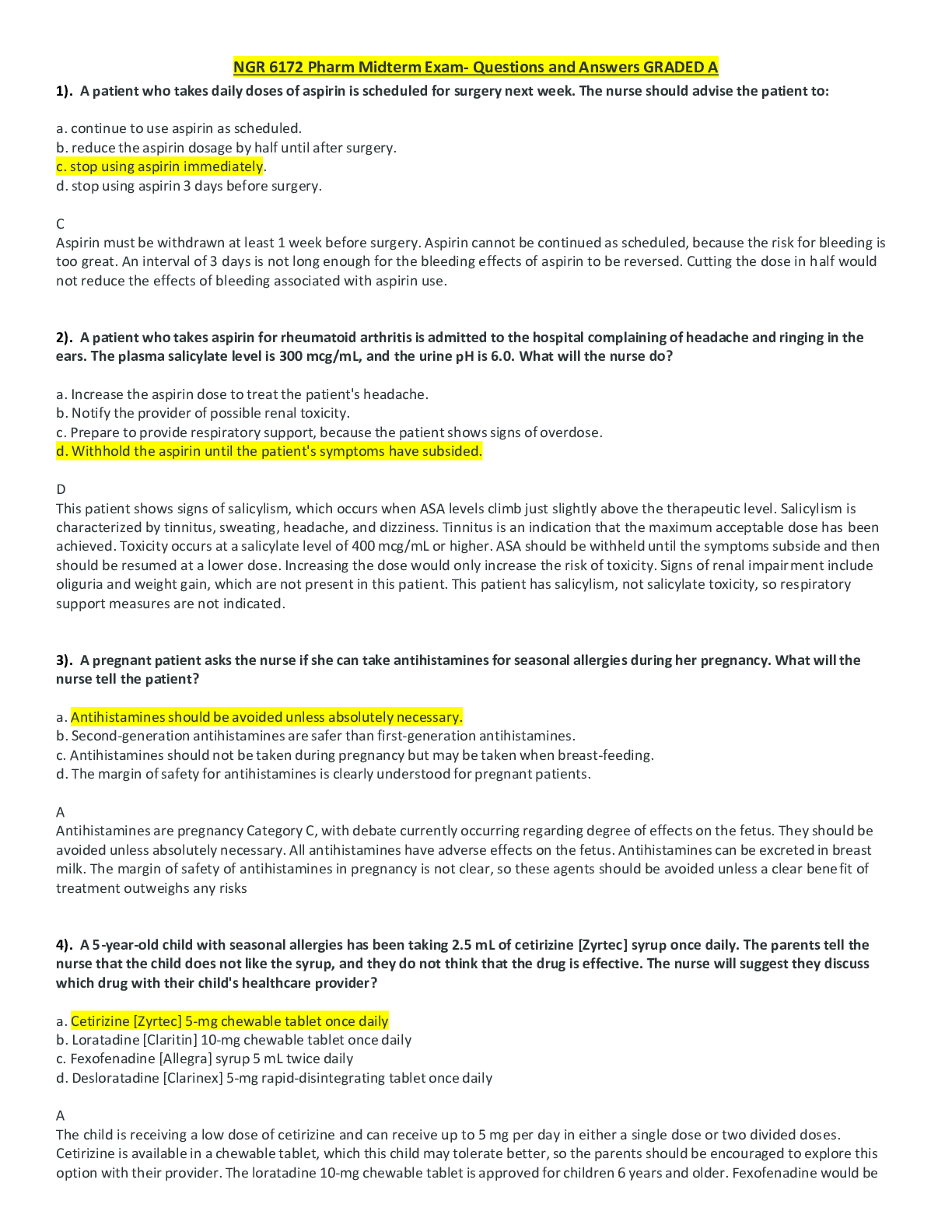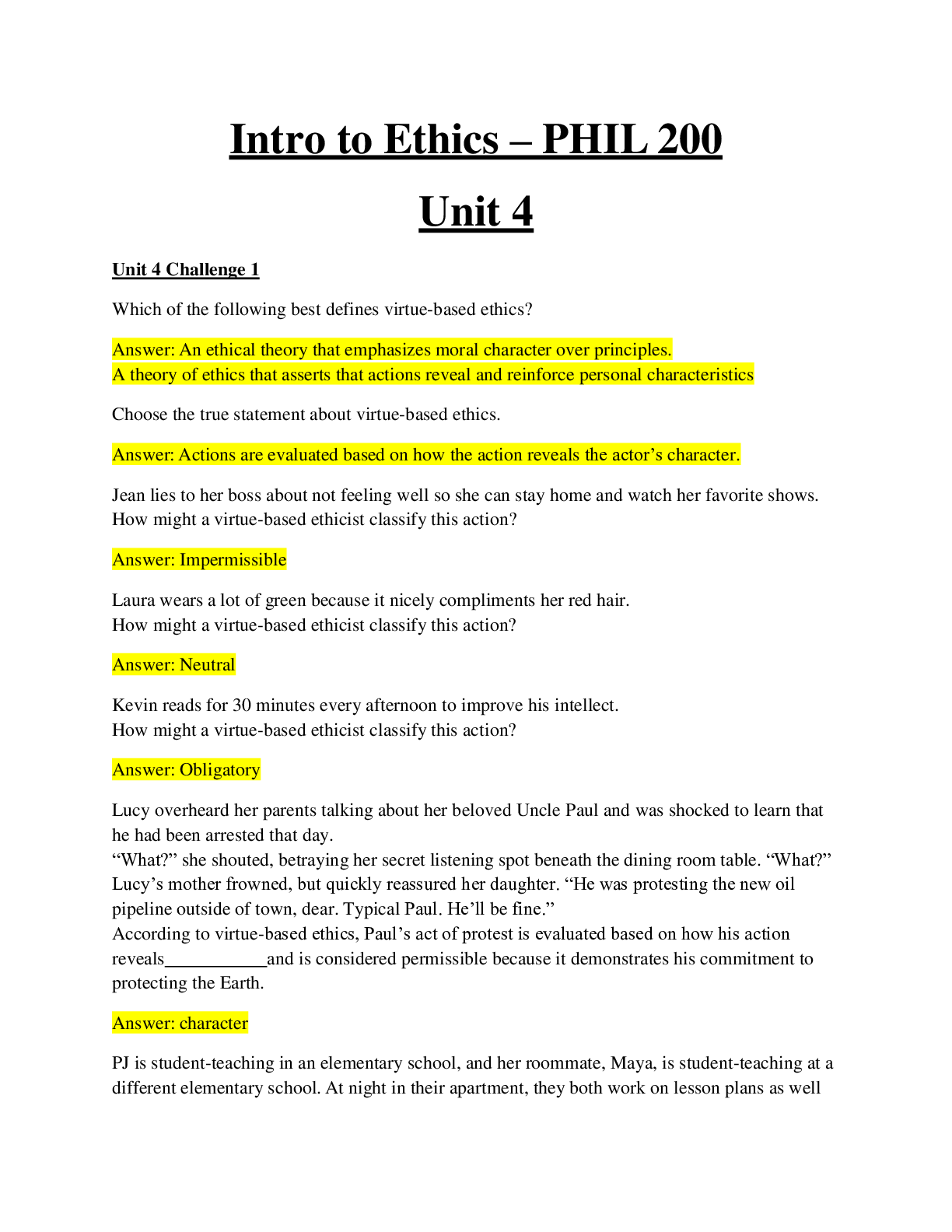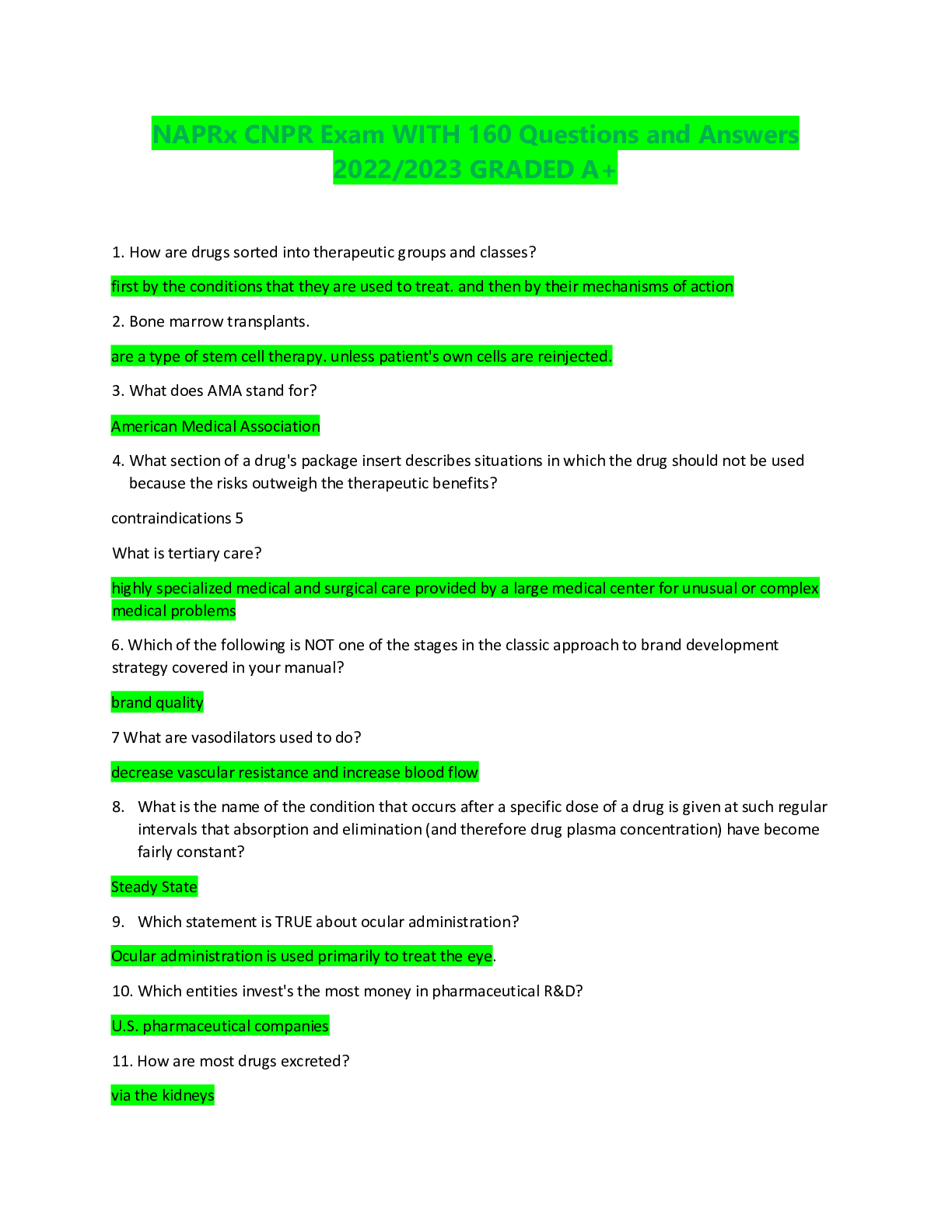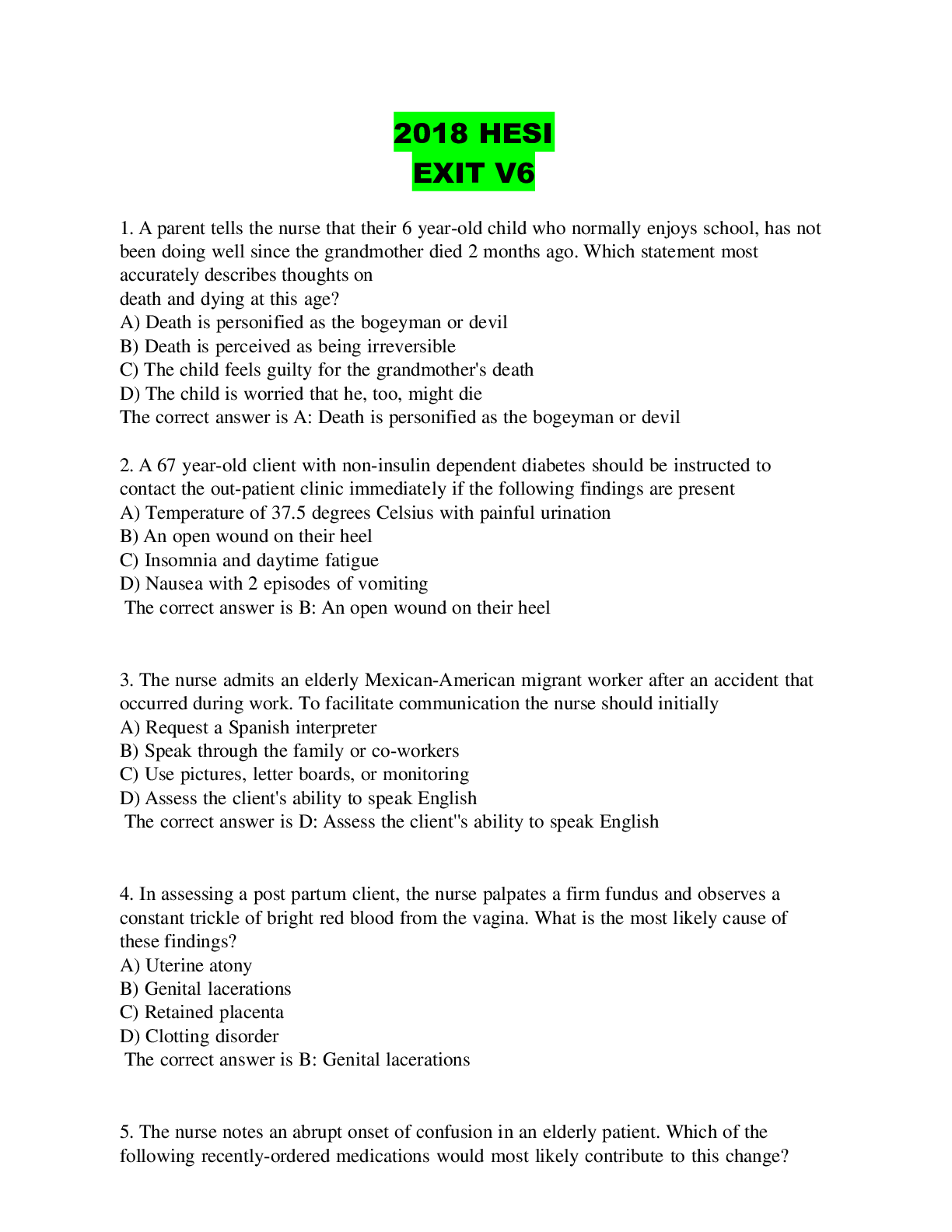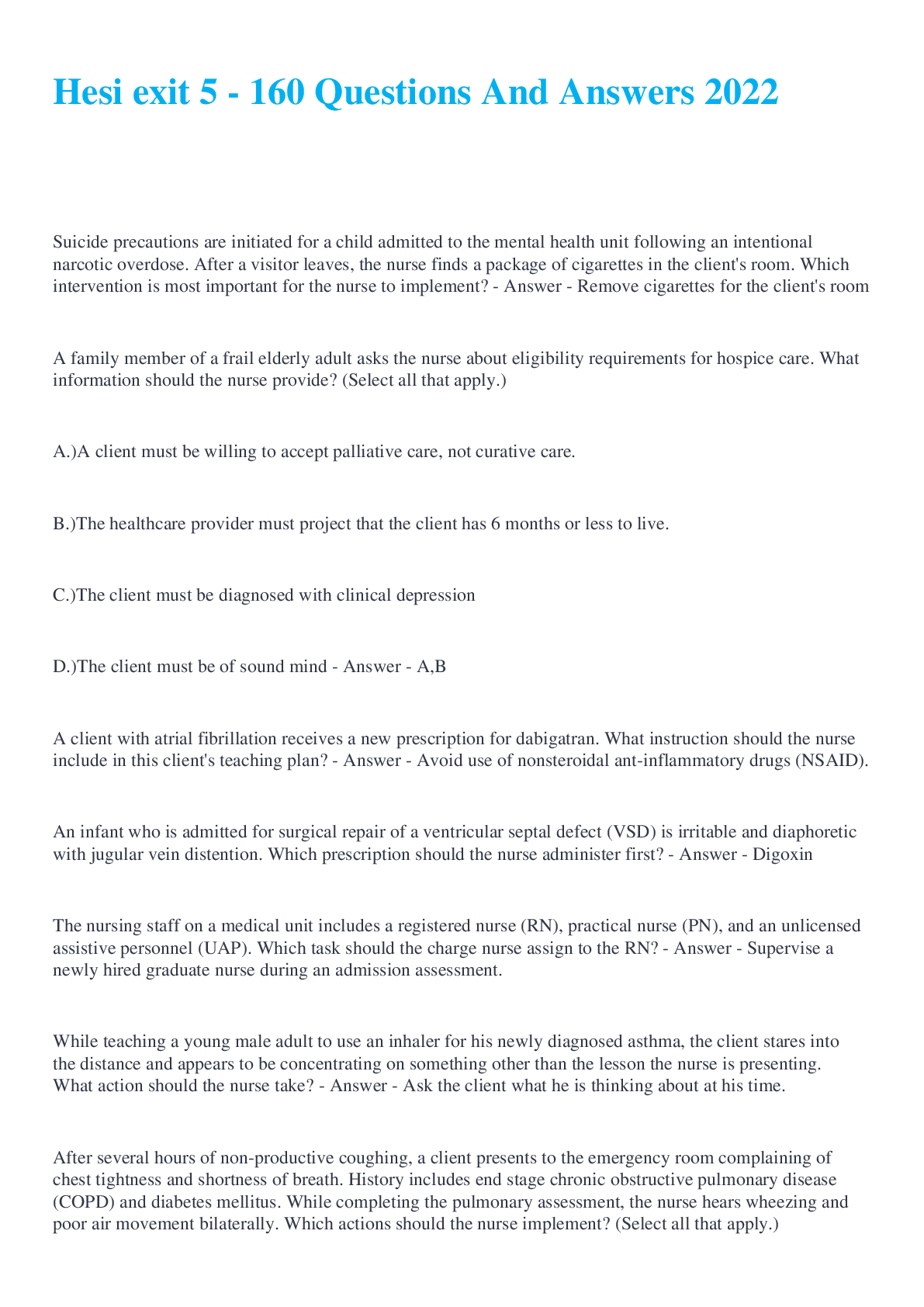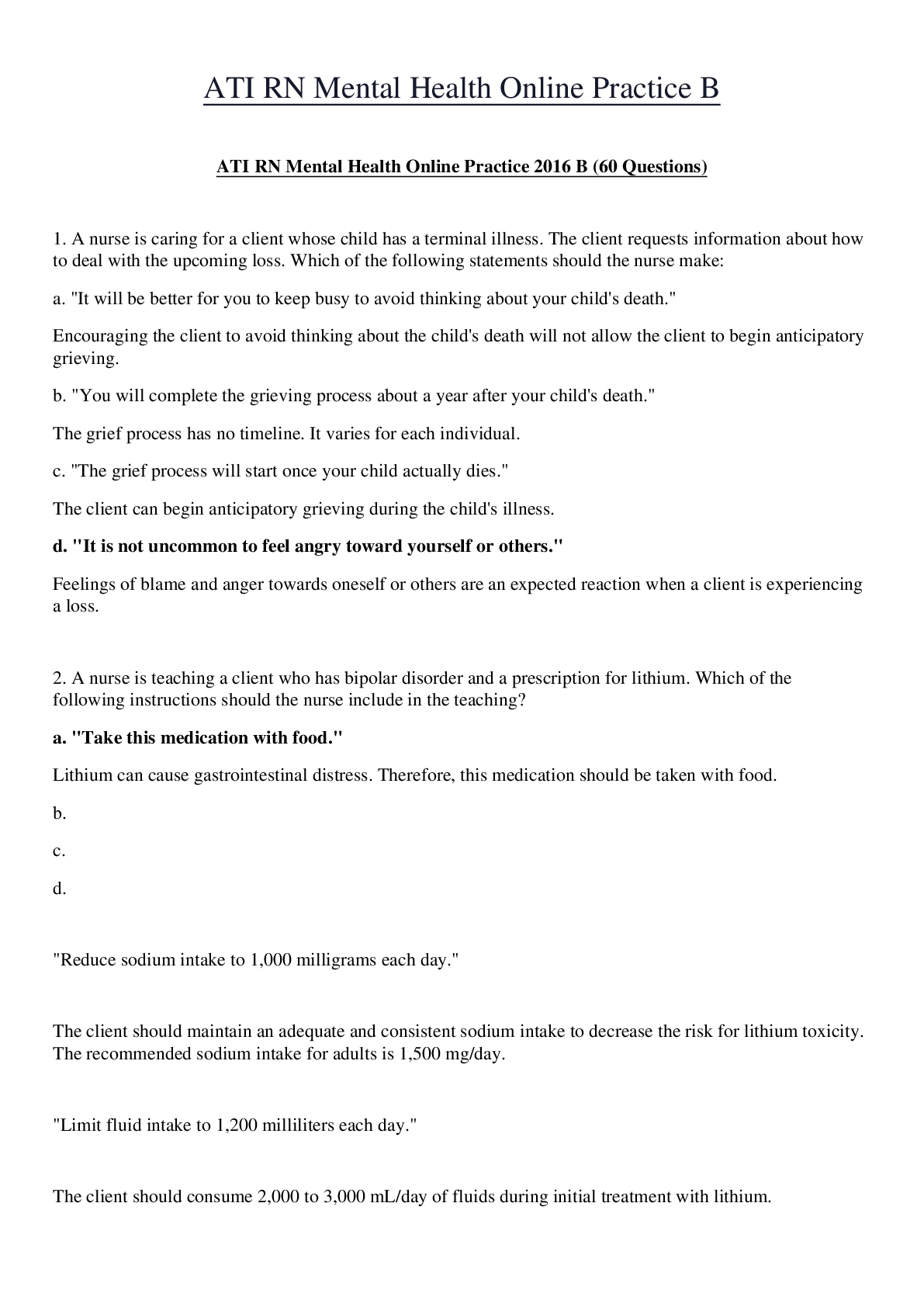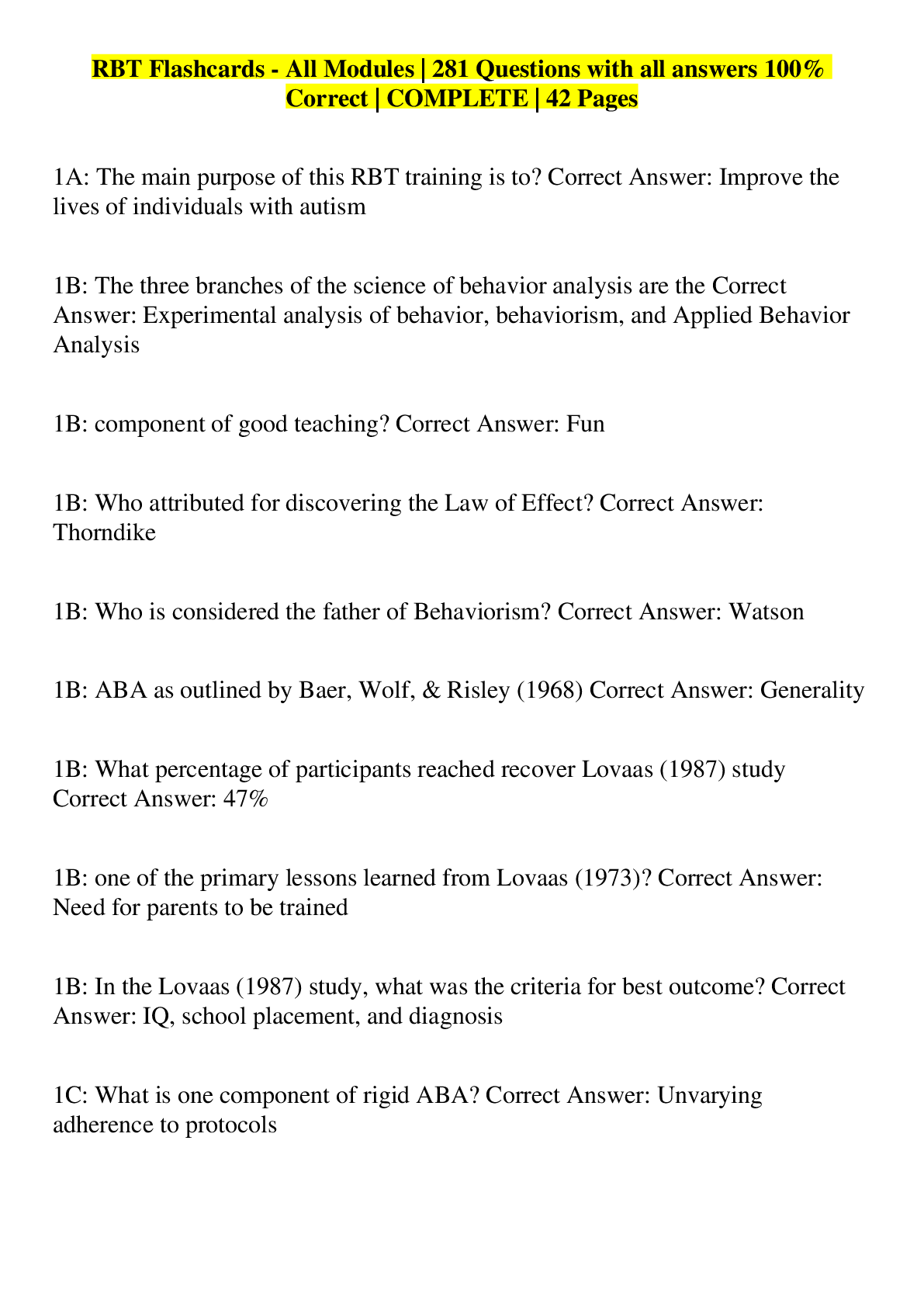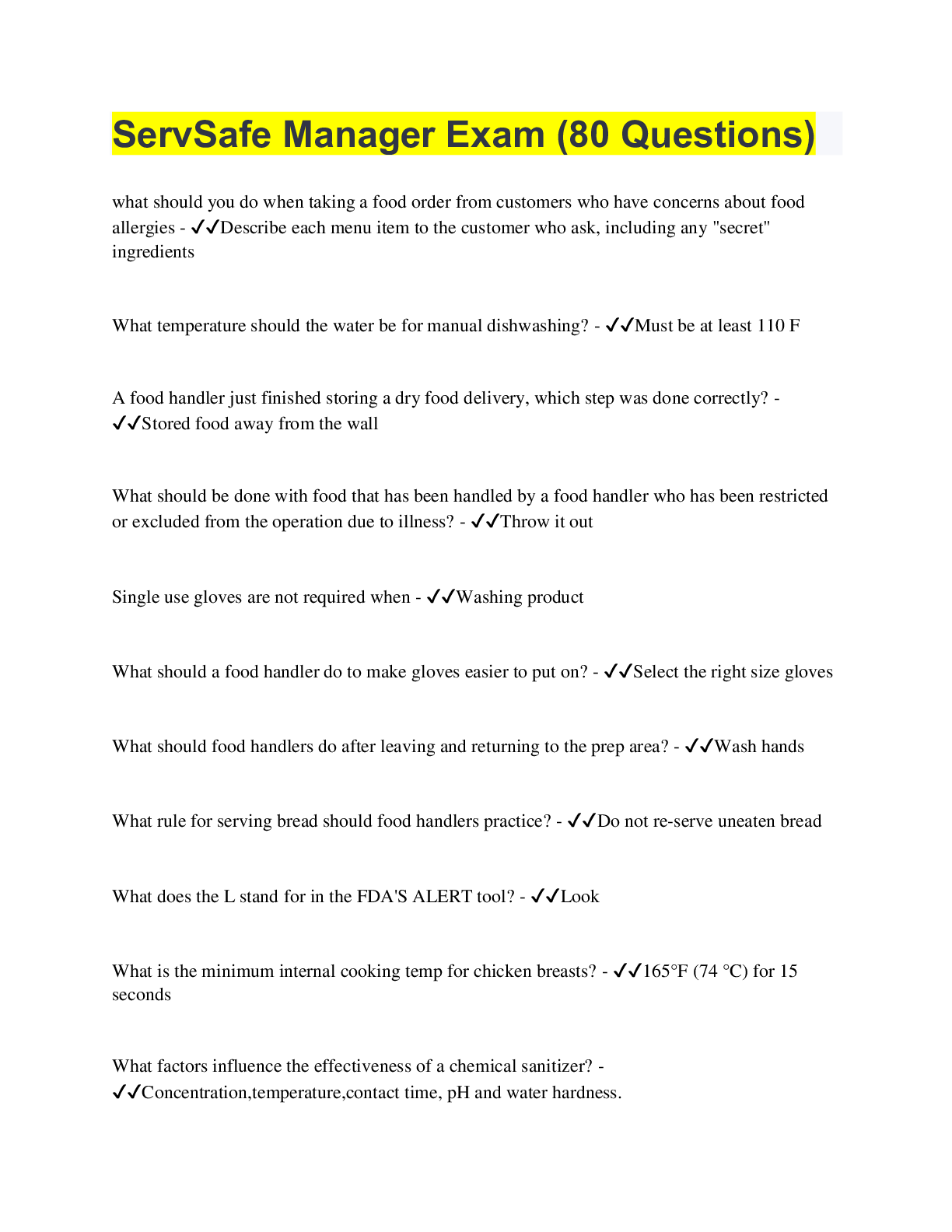Hesi Exit Rn Exam 2022 v3 Real 160 Questions And Answers
Document Content and Description Below
HESI EXIT RN 2022 V3 160 Questions 1. A male client with stomach cancer returns to the unit following a total gastrectomy. He has a nasogastric tube to suction and is receiving Lactate... d Ringer’s solution at 75 mL/hour IV. One hour after admission to the unit, the nurse notes 300 mL of blood in the suction canister, the client’s heart rate is 155 beats/minute, and his blood pressure is 78/48 mmHg. In addition to reporting the finding to the surgeon. Which action should the nurse implement first? a. Measure and document the client’s urinary output. b. Request the client’s reserved unit if packed red blood cells. c. Prepare the placement of a central venous catheter. d. Increase the infusion rate of Lactated Ringer’s solution. 2. an adult male who fell 20 feet from the roof of this home has multiple injuries, including a right pneumothorax. Chest tubes were inserted in the emergency department prior to his transfer to the intensive care unit (ICU). the nurse notes that the suction control chamber is bubbling at the - 10 cm H2O mark, with fluctuation in the water seal, and over the past hour 75 ml of bright red blood is measured in the collection chamber. Which intervention should the nurse implement? a. Add sterile water to the suction control chamber. b. Give blood from the collection chamber as autotransfusion c. Manipulate blood in tubing to drain into chamber. d. Increase wall suction to eliminate fluctuation in water seal. 3. A client who received hemodialysis yesterday is experiencing a blood pressure of 200/100 mmHg, heart rate 110 beats/minute, and respiratory rate 36 breaths/minute. The client is manifesting shortness of breath, bilateral 2+ pedal edema, and an oxygen saturation on room air of 89%. Which action should the nurse take first? a. Elevate the foot of the bed. b. Restrict the client’s fluid. c. Begin supplemental oxygen. d. Prepare the client for hemodialysis. 4. A client with Addison’s crisis is admitted for treatment with adrenal cortical supplementation. Based on the client’s admitting diagnosis, which findings require immediate action by the nurse? (Select all that apply) a. Headache and tremors b. Irregular heart rate c. Skin hyperpigmentation d. Postural hypotension e. Pallor and diaphoresis 5. An older client is admitted with fluid volume deficit and dehydration. Which assessment finding is the best indicator of hydration that the nurse should report to the healthcare provider? a. Urine specific gravity is 1.040 b. Systolic blood pressure decreases 10 points when standing. c. The client denies being thirsty. d. Skin tenting occurs when the client’s forearm is pinched. 6. After an inservice about electronic health record (EHR) security and safeguarding client information, the nurse observes a colleague going home with printed copies of client information in a uniform pocket. Which action should the nurse take? a. File a detailed incident report with the specific hiring facility. b. Warn the colleague that their actions are unprofessional. c. Comment anonymously about the action of a staff discussion board. d. Communicate the colleague’s actions to the unit charge nurse. 7. The nurse is evaluating a tertiary prevention program for clients with cardiovascular disease implemented in a rural health clinic. Which outcome indicate the program is effective? a. At-risk clients received an increased number of routine health screenings. b. Clients reported having new confidence in making healthy food choices. c. Clients who incurred disease complications promptly received rehabilitation. d. Client relapse rate of 30% in a 5-year community-wide anti-smoking campaign. 8. The nurse is caring for a client with chronic obstructive pulmonary disease (COPD) who uses oxygen at 2 L/minute per nasal cannula continuously. The nurse observes that the client is having increased shortness of breath with respirations at 23 breaths/minute. Which action should the nurse implement first? a. Determine if the client is experiencing any anxiety. b. Auscultate the client’s bilateral lung sounds and oxygen saturation. c. Notify the healthcare provider about the client’s distress. d. Assess the delivery mechanism of the oxygen tank, tubing, and cannula. 9. Which statement by a client who is 24 hours post-subtotal thyroidectomy requires an immediate investigation by the nurse? a. “When I get out of bed quickly, I feel a little dizzy.” b. “The dressing over my incision feels like it is too tight.” c. “I’m most comfortable when the head of the bed is raised.” d. “This IV infusion makes me urinate more often than usual.” 10. An older adult male who is in his early 70’s is admitted to the emergency department because of a COPD exacerbation. This client is struggling to breathe and the healthcare team is preparing for endotracheal intubation. The spouse’s wife, who is 30 years younger than the client, asks the nurse to stop the procedure and provide the nurse a copy of the client’s living will. Which action should the nurse take? a. Facilitate a family meeting with the palliative care team. b. Notify the healthcare provider of the client’s wishes. c. Place a certified copy of the living will in the client’s record. d. Alert the nursing staff of the client’s don’t resuscitate status. 11. An unlicensed assistive personnel (UAP) is assigned to provide personal care for a client whose prescribed activity is bedrest with bedside commode use. The UAP reports to the nurse that the client is so obese that the UAP feels unable to safely assist the client in transferring from the bed to the bedside commode. How should the nurse respond? a. Determine the client’s level of mobility and need for assistance. b. Instruct the UAP that all clients deserve equal care. c. Advice the client to maintain bedrest so that safety can be ensured. d. Assign another UAP to care for the client. 12. A nurse determines that more than 25% of the students at a middle school are overweight. The nurse presents the information at the parent-teacher meeting. What action is most important for the nurse to include in the meeting? a. Provide information on ways to increase activity for the family. b. Have several teachers talk about health risks associated with obesity. c. Distribute a shopping list of suggested healthy snack items. d. Determine the parents’ degree of concern about their children’s weight. 13. After several months of chronic fatigue, morning stiffness, and join pain, a young adult is diagnosed with rheumatoid arthritis, and the healthcare provider prescribes prednisone. Which education should the nurse provide the client with regard to taking prednisone? a. Take prednisone doses before meals on an empty stomach. b. Wear sunglasses when exposed to bright sunlight. c. If sequential doses are missed, notify the healthcare provider. d. Schedule a monthly laboratory visit for a complete blood count. 14. The psychiatric nurse is caring for clients on an adolescent unit. Which client requires the nurse’s immediate attention? a. A 16-year-old client diagnosed with major depression who refuses to participate in group. b. A 14-year-old client with anorexia nervosa who is refusing to eat the evening snack. c. An 18-year-old client with antisocial behavior who is being yelled at by other clients d. A 17-year-old client diagnosed with bipolar disorder who is pacing around the lobby.. 15. The nurse caring for a child with mononucleosis can expect the child to exhibit which symptoms? a. Positive Epstein-Barr, and malaise. b. Ear pain and fever. c. Elevated WBC and sedimentation rate. d. Increased BUN and serum creatinine. 16. A client arrives for an annual physical exam and complains of having calf pain. The client’s health history reveals peripheral atrial disease. Which question should the nurse ask the client about expected finding related to chronic arterial symptoms? a. Were your legs ever suddenly swollen, red, warm, and painful? b. Does the calf pain occur when walking short distances? c. Did you receive treatment for weeping ulcers on lower legs? d. Have you experienced ankle edema and varicose veins? 17. The nurse is preparing to send a client to the cardiac catheterization lab for an angioplasty. Which client report is most important for them to explore further prior to the start of the procedure? a. Drank a glass of water in the past 2 hours. b. Reports left chest wall pain prior to admission. c. Verbalize a fear of being in a confined space. d. Experience facial swelling after eating crab. 18. The nurse is assessing a 4-year-old child with eczema. The child’s skin is dry and scaly, and the mother reports that the child frequently scratches the lesions on the skin to the point of causing bleeding. Which guideline is indicated for care of this child? a. Keep the nails trimmed short. b. Apply baby lotion to the skin twice daily. c. Bathe the child daily with bath oil. d. Allow the child to wear only 100% cotton clothing. 19. A new mother on the postpartum unit runs out of the room screaming that her newborn infant’s crib is empty and the baby is missing. What action should the nurse take first? a. Determine if the newborn is in the nursery. b. Activate the lockdown procedure. c. Ask the mother if any visitors were expected to arrive. d. Match ID bands of all infants and mothers on the unit. 20. While providing a health history, a female client tells the clinic nurse that she frequently thinks about hurting herself. Which question is most important for the nurse to ask? a. “Do you often have feeling of sadness?” b. “Are you having problems concentrating?” c. “Have you though about taking your life?” d. “What problems are you facing right now?” 21. A college student brings a dorm roommate to the campus clinic because the roommate has been talking to someone who is not present. The client tells the nurse that the voices are saying, “kill, kill.” What question should the nurse ask the client next? a. “When did these voices begin?” b. “Have you taken any hallucinogens?” c. “Are you planning to obey the voices?” d. “Do you believe the voices are real?” 22. The nurse is developing a plan of care for a client who reports tingling of the feet and who is newly diagnosed with peripheral vascular disease. Which outcome should the nurse include in the plan of care for this client? a. The client will express acceptance of their newly diagnosed health status. b. The nurse will encourage the client to walk thirty minutes everyday. c. The client’s blood pressure readings will be less than 160/90 mmHg. d. The client’s skin on the lower legs will be intact at the next clinical visit. 23. When conducting diet teaching for a client who was diagnosed with hypertension, which food should the nurse encourage the client to eat? (select all that apply.) a. . Fruits without sauce b. Canned soup. c. Fresh or frozen vegetables without sauce. d. Cottage cheese. e. Pickled olives. 24. A client with bacterial meningitis is receiving phenytoin. Which assessment finding indication to the nurse that the client is experiencing a therapeutic response to the phenytoin? a. Increased time of ambulation between periods of rest. b. Decrease in intracranial pressure and cerebral edema. c. Absence of seizure activity for the duration of treatment. d. Normal electroencephalogram after drug administration. 25. The nurse observes a client prepare a meal in the kitchen of a rehabilitation facility prior to discharge. Which behaviors indicate the client understands how to maintain balance safely? (Select all that apply) c. Widens stance while working near the sink. d. Bends from the waist to pick trash off the floor. e. Leans forward to pull a pan from a high shelf. 26. An older client is admitted to the hospital because of recurring transient ischemic attacks. Neurological serial assessments for the past 24 hours were within normal limits. One day after admission, the client suddenly becomes confused and combative indicating impaired mental status (IMS). What intervention should the nurse implement first? a. Document neurologic changes. b. Reduce environmental stimuli. c. Administer prescribed neuroleptic. d. Review medications for interactions. a. Brings a heavy can close to body before lifting. b. Locks knees while preparing food on the counter. 27. The charge nurse in an extended care facility is organizing unit activities for the day. Which action may be safely delegated to the practical nurse (PN)? a. Measure the client’s body weight each morning. b. Establish blood pressure parameters for client monitoring c. Evaluate a staff member providing wound care. d. Evaluate client teaching through return demonstration. 28. During shift report, the charge nurse receives notice of several problems. Which problem should the nurse address first? a. The census report has not been completed. b. A client’s wife has asked to speak with the charge nurse. c. One staff member has not reported to work. d. A bucket of water was spilled in the hallway. 29. An older adult client with chronic emphysema is admitted to the emergency room from home with acute onset of weakness, palpitations, and vomiting. Which information is most important for the nurse to obtain during the initial interview? a. History of smoking over the past 6 months. b. Sleep patterns during the previous few week. c. Activity level prior to onset of symptoms. d. Recent compliance with prescribed medications. 30. The nurse is feeding an older adult who was admitted with aspiration pneumonia. The client is weak and begins coughing while attempting to drink through a straw. Which intervention should the nurse implement? a. Assess the client’s oral cavity for ulcerations. b. Monitor the client when using a straw for liquids. c. Teach coughing and deep breathing exercises. d. Request thick nectar liquids for the client. 31. A male client with right-sided weakness calls for assistance with ambulating to the bathroom. What action should the nurse implement? a. Bring a bedside commode to the client. b. Stand on the client’s right side as he walks. c. Walk directly behind the client to prevent a fall. d. Give the client a cane to hold in his right hand. 32. An older client is admitted to the psychiatric unit for assessment of a recent onset of dementia. The nurse notes that in the evening this client often becomes restless, confused, and agitated. Which intervention is most important for the nurse to implement? a. Ask family members to remain with the client in the evening from 1700 to 2100 p.m. b. Ensure that the client is assigned to a room close to the nurses’ station. c. Postpone administration of nighttime medications until after 2300 p.m. d. Administer a prescribed PRN benzodiazepine at the onset of a confused state. 33. The nurse is caring for a client who is having a sickle cell crisis. What intervention should the nurse include in this client’s plan of care? a. Ensure adequate IV and oral fluid intake. b. Provide ice packs to major joint areas. c. Space analgesics to prevent addiction to narcotics. d. Re-enforce the importance of nutritional balance. 34. The nurse is teaching a primigravida about preeclampsia. Which finding are indicators of preeclampsia and should be reported to the healthcare provider? (select all that apply.) a. c. Lack of appetite. d. Urinary frequency. e. Chills and fever. f. Swollen hands. 35. A new nurse preparing to irrigate an intravenous catheter is attaching a 24-gauge needle. Which action should the charge nurse implement? a. Suggest the nurse use a 20-gauge needle. b. Direct the nurse to change the IV tubing. c. Instruct the nurse to remove the needle. d. Prompt the nurse to apply povidone to the site. 36. A client with syndrome of inappropriate antidiuretic hormone secretion (SIDH) is admitted with hyponatremia. Which intervention is most important for the nurse to include in the plan of care to protect the client from injury? a. Initiate seizure precautions. b. Assess neurological status every 8 hours. c. Limit oral water intake. d. Administer a hypertonic IV fluids as prescribed. Blurred vision b. Headache. 37. The nurse is assigned to provide care for a client who is scheduled for a laparoscopic cholecystectomy in two hours, at 0900, what nursing action is most important? a. Confirm that the client has been NPO since midnight. b. Review postoperative instructions with the client. c. Offer to assist the client to the restroom to void. d. Determine when the client last had pain medication. 38. The nurse is conducing a visual screening of a group of older adults. Which finding should the nurse report to the healthcare provider immediately? a. Gradual onset of continuous eye pain and blurred vision. b. Recent change in the ability to read and drive after dark. c. Gray-white circle around the iris of both eyes. d. Cloudy opacity of the crystalline lens. 39. A 15-year-old male client was recently diagnosed with type 1 diabetes mellitus. He tells the nurse that he is having difficulty adhering to his meal plan when he is with his friends. What nursing intervention is best for the nurse to implement? a. Recommend he avoid fast food restaurants until he is familiar with his prescribed diet. b. Advise him to take his own food with him when going to fast food restaurants with his friends. c. Encourage him to find activities to do with his friends that do not involve eating. d. Assist him in identifying popular fast foods that are within his meal plan for diabetes. 40. A male client in the final stages of terminal cancer tells his nurse that he wishes he could just be allowed to die. The client states that he is tired of fighting his illness and is only continuing treatments because his family wants him to live. Which action should the nurse take? a. Notify the family that treatments have been discontinued. b. Arrange a meeting with the family, physician, and client. c. Ask the chaplain to discuss death issues with the client. d. Request a consultation with the hospital social worker. 41. Five days after surgical fixation of a fractured femur, a client suddenly reports chest pain and difficulty in breathing..... had a pulmonary embolus. What action should the nurse take first? a. Bring the emergency crash cart to the bedside. b. Prepare a continuous heparin infusion per protocol. c. Provide supplemental oxygen. d. Notify the healthcare provider. 42. A client admitted with a liver abscess is scheduled for surgical evacuation and drainage of the abscess tomorrow morning. Nursing assess .... Client’s abdominal pain has increased from 4 to 8 on a 10-point scale in the last four hours. What is priority nursing action? a. Notify the surgeon of increasing abdominal pain. b. Administer the nest scheduled dose of antibiotic. c. Encourage the client to cough and deep breath. d. Assess for a change in the client’s bowel sounds. 43. A female client with chronic kidney disease and renal failure has an indwelling peritoneal catheter in ..... used for peritoneal dialysis. While bathing, the her abdominal dressing becomes wet. What action should the nurse take? a. Change the dressing. b. Reinforce the dressing. c. Flush the peritoneal dialysis catheter. d. Scrub the catheter with povidone-iodine. 44. The nurse is developing a plan of care for an older male client with type 2 diabetes who reports blurred vision. Which outcome shows a plan of care for this client? a. The client will express acceptance of his changing health status. b. The client’s family will state signs and symptoms about the disease. c. The nurse will demonstrate the procedure for accurate eye care. d. The client’s daily blood pressure will be less than 140/80 mmHg this month. 45. The nurse identifies an electrolyte imbalance, an elevated pulse rate, and a weight gain of 4.4 lbs (2 kg) in 24 hours for a client with chronic kidney disease. What intervention should the nurse include in the plan of care? a. Monitor serum electrolytes daily. b. Provide only distilled water. c. Document abdominal girth. d. Perform range of motion exercises. 46. A client with postpartum depression, who is admitted to the behavioral health unit, refuses to leave her room or eat meals. In addition to patient’s safety, which short-term goal should the nurse include in the plan of care? a. Attends one group activity per day. b. Sleeps at least 6 hours per night. c. Engages in one client-to-client interaction daily. d. Consumes 3 meals and 1500 mL of fluid per day. 47. Which information is a priority for the RN to reinforce to an older client after intravenous pyelogram? a. b. c. d. Eat a light diet for the rest of the day Rest for the next 24 hours since the preparation and the test is tiring. During waking hours drink at least 1 8-ounce glass of fluid every hour for the next 2 days 48. A client has altered renal function and is being treated at home. The nurse recognizes that the most accurate indicator of fluid balance during the weekly visits is a. b. c. d. Difference in the intake and output Changes in the mucous membranes Skin turgor Weekly weight 49. A client has been diagnosed with Zollinger-Ellison syndrome.Which information is most important for the nurse to reinforce with the client? a. It is a condition in which one or more tumors called gastrinomas form in the pancreas or in the upper part of the small intestine (duodenum) b. It is critical to report promptly to your health care provider any findings of peptic ulcers c. Treatment consists of medications to reduce acid and heal any peptic ulcers and, if possible, surgery to remove any tumors d. With the average age at diagnosis at 50 years the peptic ulcers may occur at unusual areas of the stomach or intestine 50. A primigravida in the third trimester is hospitalized for preeclampsia. The nurse determines that the client’s blood pressure is increasing. Which action should the nurse take first? a. b. c. d. Check the protein level in urine Have the client turn to the left side Take the temperature Monitor the urine output Measure the urine output for the next day and immediately notify the health care provider if it should decrease. 51. The nurse is caring for a client in atrial fibrillation. The atrial heart rate is 250 and the ventricular rate is controlled at 75. Which of the following findings is cause for the most concern? a. Diminished bowel sounds b. Loss of appetite c. A cold, pale lower leg d. Tachypnea 52. The client with infective endocarditis must be assessed frequently by the home health nurse. Which finding suggests that antibiotic therapy is not effective, and must be reported by the nurse immediately to the healthcare provider? A) Nausea and vomiting B) Fever of 103 degrees Fahrenheit (39.5 degrees Celsius) C) Diffuse macular rash D) Muscle tenderness 53. A client who had a vasectomy is in the post recovery unit at an outpatient clinic. Which of these points is most important to be reinforced by the nurse? A) B) This procedure doesn't impede the production of male hormones or the production of sperm in the testicles. The sperm can no longer enter your semen and no sperm are in your ejaculate. C) After your vasectomy, strenuous activity needs to be avoided for at least 48 hours. If your work doesn't involve hard physical labor, you can return to your job as soon as you feel up to it. The stitches generally dissolve in seven to ten days. D) The health care provider at this clinic recommends rest, ice, an athletic supporter or over-the-counter pain medication to relieve any discomfort. 54. A client who is to have antineoplastic chemotherapy tells the nurses of a fear of being sick all the time and wishes to try acupuncture. Which of these beliefs stated by the client would be incorrect about acupuncture? A) Some needles go as deep as 3 inches, depending on where they're placed in the body and what the treatment is for. The needles usually are left in for 15 to 30 minutes. B) In traditional Chinese medicine, imbalances in the basic energetic flow of life — known as qi or chi — are thought to cause illness. C) The flow of life is believed to flow through major pathways or nerve clusters in your body. D) By inserting extremely fine needles into some of the over 400 acupuncture points in various combinations it is believed that energy flow will rebalance to allow the body's natural healing mechanisms to take over. Until the health care provider has determined that your ejaculate doesn't contain sperm, continue to use another form of contraception. 55. The nurse is discussing with a group of students the disease Kawasaki. What statement made by a student about Kawasaki disease is incorrect? A) It also called mucocutaneous lymph node syndrome because it affects the mucous membranes (inside the mouth, throat and nose), skin and lymph nodes. B) In the second phase of the disease, findings include peeling of the skin on the hands and feet with joint and abdominal pain C) D) Initially findings are a sudden high fever, usually above 104 degrees Fahrenheit, which lasts 1 to2 weeks 56. A client has viral pneumonia affecting 2/3 of the right lung. What would be the best position to teach the client to lie in every other hour during first 12 hours after admission? A) Side-lying on the left with the head elevated 10 degrees B) Side-lying on the left with the head elevated 35 degrees C) Side-lying on the right with the head elevated 10 degrees D) Side-lying on the right with the head elevated 35 degrees 57. A client has an indwelling catheter with continuous bladder irrigation after undergoing a transurethral resection of the prostate (TURP) 12 hours ago. Which finding at this time should be reported to the health care provider? A) Light, pink urine B) occasional suprapubic cramping C) minimal drainage into the urinary collection bag D) complaints of the feeling of pulling on the urinary catheter 58. A nurse is performing CPR on an adult who went into cardiopulmonary arrest. Another nurse enters the room in response to the call. After checking the client’s pulse and respirations, what should be the function of the second nurse? A) Relieve the nurse performing CPR B) Go get the code cart C) Participate with the compressions or breathing D) Validate the client's advanced directive Kawasaki disease occurs most often in boys, children younger than age 5 and children of Hispanic descent 59. The nurse assesses a 72 year-old client who was admitted for right sided congestive heart failure. Which of the following would the nurse anticipate finding? A) Decreased urinary output B) Jugular vein distention C) Pleural effusion D) Bibasilar crackles 60. A client with heart failure has a prescription for digoxin. The nurse is aware that sufficient potassium should be included in the diet because hypokalemia in combination with this medication A) Can predispose to dysrhythmias B) May lead to oliguria C) May cause irritability and anxiety D) Sometimes alters consciousness 61. A nurse assesses a young adult in the emergency room following a motor vehicle accident. Which of the following neurological signs is of most concern? A) Flaccid paralysis B) Pupils fixed and dilated C) Diminished spinal reflexes D) Reduced sensory responses 62. A 14 year-old with a history of sickle cell disease is admitted to the hospital with a diagnosis of vaso-occlusive crisis. Which statements by the client would be most indicative of the etiology of this crisis? A) ”I knew this would happen. I've been eating too much red meat lately." B) ”I really enjoyed my fishing trip yesterday. I caught 2 fish." C)”I have really been working hard practicing with the debate team at school." D)”I went to the health care provider last week for a cold and I have gotten worse." 63. Which these findings would the nurse more closely associate with anemia in a 10 month-old infant? A) Hemoglobin level of 12 g/dI B) Pale mucosa of the eyelids and lips C) Hypoactivity D) A heart rate between 140 to 160 64. The nurse is caring for a client in hypertensive crisis in an intensive care unit. The priority assessment in the first hour of care is A) Heart rate B) Pedal pulses C) Lung sounds D) Pupil responses 65. Which of these clients who are all in the terminal stage of cancer is least appropriate to suggest the use of patient controlled analgesia (PCA) with a pump? A) A young adult with a history of Down's syndrome B) A teenager who reads at a 4th grade level C) An elderly client with numerous arthritic nodules on the hands D) A preschooler with intermittent episodes of alertness 66. The nurse is about to assess a 6 month-old child with nonorganic failure-to thrive (NOFTT). Upon entering the room, the nurse would expect the baby to be A) Irritable and "colicky" with no attempts to pull to standing B) Alert, laughing and playing with a rattle, sitting with support C)Skin color dusky with poor skin turgor over abdomen D) Pale, thin arms and legs, uninterested in surroundings 67. As the nurse is speaking with a group of teens which of these side effects of chemotherapy for cancer would the nurse expect this group to be more interested in during the discussion? A) Mouth sores B) Fatigue C) Diarrhea D) Hair loss 68. While caring for a client who was admitted with myocardial infarction (MI) 2 days ago, the nurse notes today's temperature is 101.1 degrees Fahrenheit (38.5 degrees Celsius). The appropriate nursing intervention is to A) Call the health care provider immediately B) Administer acetaminophen as ordered as this is normal at this time C) Send blood, urine and sputum for culture D) Increase the client's fluid intake 69. A client is admitted for first and second degree burns on the face, neck, anterior chest and hands. The nurse's priority should be A) Cover the areas with dry sterile dressings B) Assess for dyspnea or stridor C) Initiate intravenous therapy D) Administer pain medication 70. Which of these clients who call the community health clinic would the nurse ask to come in that day to be seen by the health care provider? A) I started my period and now my urine has turned bright red. B) I am an diabetic and today I have been going to the bathroom every hour. C) I was started on medicine yesterday for a urine infection. Now my lower belly hurts when I go to the bathroom. D) I went to the bathroom and my urine looked very red and it didn’t hurt when I went. 71. A middle aged woman talks to the nurse in the health care provider’s office about uterine fibroids also called leiomyomas or myomas. What statement by the woman indicates more education is needed? A) I am one out of every 4 women that get fibroids, and of women my age – between the 30s or 40s, fibroids occurs more frequently. B) My fibroids are noncancerous tumors that grow slowly. C) My associated problems I have had are pelvic pressure and pain, urinary incontinence, frequent urination or urine retention and constipation. D) Fibroids that cause no problems still need to be taken out. 72. An elderly client admitted after a fall begins to seize and loses consciousness. What action by the nurse is appropriate to do next? A) Stay with client and observe for airway obstruction B) Collect pillows and pad the side rails of the bed C) Place an oral airway in the mouth and suction D) Announce a cardiac arrest, and assist with intubation 73. A nurse is providing care to a primigravida whose membranes spontaneously ruptured (ROM) 4 hours ago. Labor is to be induced. At the time of the ROM the vital signs were T-99.8 degrees F, P-84, R-20, BP-130/78, and fetal heart tones (FHT) 148 beats/min. Which assessment findings taken now may be an early indication that the client is developing a complication of labor? A) FHT 168 beats/min B) Temperature 100 degrees Fahrenheit. C) Cervical dilation of 4 D) BP 138/88 74. A client with pneumococcal pneumonia had been started on antibiotics 16 hours ago. During the nurse’s initial evening rounds the nurse notices a foul smell in the room. The client makes all of these statements during their conversation. Which statement would alert the nurse to a complication? A) "I have a sharp pain in my chest when I take a breath." B) "I have been coughing up foul-tasting, brown, thick sputum." C) "I have been sweating all day." D) "I feel hot off and on." 75. The nurse is performing an assessment on a client in congestive heart failure. Auscultation of the heart is most likely to reveal A) S3 ventricular gallop B) Apical click C) Systolic murmur D) Split S2 76. Which of these observations made by the nurse during an excretory urogram indicate a complicaton? A) The client complains of a salty taste in the mouth when the dye is injected B) The client’s entire body turns a bright red color C) The client states “I have a feeling of getting warm.” D) The client gags and complains “ I am getting sick.” 77. A client is diagnosed with a spontaneous pneumothorax necessitating the insertion of a chest tube. What is the best explanation for the nurse to provide this client? A) "The tube will drain fluid from your chest." B) "The tube will remove excess air from your chest." C) "The tube controls the amount of air that enters your chest." D) "The tube will seal the hole in your lung." 78. The nurse is reviewing laboratory results on a client with acute renal failure. Which one of the following should be reported immediately? A) Blood urea nitrogen 50 mg/dl B) Hemoglobin of 10.3 mg/dl C) Venous blood pH 7.30 D) Serum potassium 6 mEq/L 79. The nurse is caring for a client undergoing the placement of a central venous catheter line. Which of the following would require the nurse’s immediate attention? A) Pallor B) Increased temperature C) Dyspnea D) Involuntary muscle spasms 80. The nurse is performing a physical assessment on a client who just had an endotracheal tube inserted. Which finding would call for immediate action by the nurse? A) Breath sounds can be heard bilaterally B) Mist is visible in the T-Piece C) Pulse oximetry of 88 D) Client is unable to speak 81. A nurse checks a client who is on a volume-cycled ventilator. Which finding indicates that the client may need suctioning? A) drowsiness B) complaint of nausea C) pulse rate of 92 D) restlessness 82. The most effective nursing intervention to prevent atelectasis from developing in a post operative client is to A) Maintain adequate hydration B) Assist client to turn, deep breathe, and cough C) Ambulate client within 12 hours D) Splint incision 83. When caring for a client with a post right thoracotomy who has undergone an upper lobectomy, the nurse focuses on pain management to promote A) Relaxation and sleep B) Deep breathing and coughing C) Incisional healing D) Range of motion exercises 84. A nurse is to collect a sputum specimen for acid-fast bacillus (AFB) from a client. Which action should the nurse take first? A) Ask client to cough sputum into container B) Have the client take several deep breaths C) Provide a appropriate specimen container D) Assist with oral hygiene 85. The nurse is caring for a child immediately after surgical correction of a ventricular septal defect. Which of the following nursing assessments should be a priority? A) Blanch nail beds for color and refill B) Assess for post operative arrhythmias C) Auscultate for pulmonary congestion D) Monitor equality of peripheral pulses 86. A client has a history of chronic obstructive pulmonary disease (COPD). As the nurse enters the client's room, his oxygen is running at 6 liters per minute, his color is flushed and his respirations are 8 per minute. What should the nurse do first? A) Obtain a 12-lead EKG B) Place client in high Fowler's position C) Lower the oxygen rate D) Take baseline vital signs 87. A 4 year-old has been hospitalized for 24 hours with skeletal traction for treatment of a fracture of the right femur. The nurse finds that the child is now crying and the right foot is pale with the absence of a pulse. What should the nurse do first? A) Notify the health care provider B) Readjust the traction C) Administer the ordered PRN medication D) Reassess the foot in fifteen minutes 88. The nurse is assessing a client 2 hours postoperatively after a femoral popliteal bypass. The upper leg dressing becomes saturated with blood. The nurse's first action should be to A) Wrap the leg with elastic bandages B) Apply pressure at the bleeding site C) Reinforce the dressing and elevate the leg D) Remove the dressings and re-dress the incision 89. A client is receiving external beam radiation to the mediastinum for treatment of bronchial cancer. Which of the following should take priority in planning care? A) Esophagitis B) Leukopenia C) Fatigue D) Skin irritation 90. A client has a chest tube in place following a left lower lobectomy inserted after a stab wound to the chest. When repositioning the client, the nurse notices 200 cc of dark, red fluid flows into the collection chamber of the chest drain. What is the most appropriate nursing action? A) Clamp the chest tube B) Call the surgeon immediately C) Prepare for blood transfusion D) Continue to monitor the rate of drainage 91. A client has returned from a cardiac catheterization. Which one of the following assessments would indicate the client is experiencing a complication from the procedure? A) Increased blood pressure B) Increased heart rate C) Loss of pulse in the extremity D) Decreased urine output 92. A 60 year-old male client had a hernia repair in an outpatient surgery clinic. He is awake and alert, but has not been able to void since he returned from surgery 6 hours ago. He received 1000 mL of IV fluid. Which action would be most likely to help him void? A) Have him drink several glasses of water B) Crede’ the bladder from the bottom to the top C) Assist him to stand by the side of the bed to void D) Wait 2 hours and have him try to void again 93. The nurse is caring for a client who requires a mechanical ventilator for breathing. The high pressure alarm goes off on the ventilator. What is the first action the nurse should perform? A) Disconnect the client from the ventilator and use a manual resuscitation bag B) Perform a quick assessment of the client's condition C) Call the respiratory therapist for help D) Press the alarm re-set button on the ventilator 94. The health care provider order reads "aspirate nasogastric feeding (NG) tuber every 4 hours and check pH of aspirate." The pH of the aspirate is 10. Which action should the nurse take? A) Hold the tube feeding and notify the provider B) Administer the tube feeding as scheduled C) Irrigate the tube with diet cola soda D) Apply intermittent suction to the feeding tube 95. To prevent unnecessary hypoxia during suctioning of a tracheostomy, the nurse must A) Apply suction for no more than 10 seconds B) Maintain sterile technique C) Lubricate 3 to 4 inches of the catheter tip D) Withdraw catheter in a circular motion 96. An antibiotic IM injection for a 2 year-old child is ordered. The total volume of the injection equals 2.0 ml The correct action is to A) administer the medication in 2 separate injections B) give the medication in the dorsal gluteal site C) call to get a smaller volume ordered D) check with pharmacy for a liquid form of the medication skip 97. The nurse receives an order to give a client iron by deep injection. The nurse know that the reason for this route is to A) enhance absorption of the medication B) ensure that the entire dose of medication is given C) provide more even distribution of the drug D) prevent the drug from tissue irritation Skip 98. A client with heart failure has Lanoxin (digoxin) ordered. What would the nurse expect to find when evaluating for the therapeutic effectiveness of this drug? A) diaphoresis with decreased urinary output B) increased heart rate with increase respirations C) improved respiratory status and increased urinary output D) decreased chest pain and decreased blood pressure 99. While providing home care to a client with congestive heart failure, the nurse is asked how long diuretics must be taken. What is the nurse’s best response? A) ”As you urinate more, you will need less medication to control fluid." B) ”You will have to take this medication for about a year." C) ”The medication must be continued so the fluid problem is controlled." D) ”Please talk to your health care provider about medications and treatments." 100. A client is being discharged with a prescription for chlorpromazine (Thorazine). Before leaving for home, which of these findings should the nurse teach the client to report? A) Change in libido, breast enlargement B) Sore throat, fever C) Abdominal pain, nausea, diarrhea D) Dsypnea, nasal congestion 101. A client is recovering from a hip replacement and is taking Tylenol #3 every 3 hours for pain. In checking the client, which finding suggests a side effect of the analgesic? A) Bruising at the operative site B) Elevated heart rate C) Decreased platelet count D) No bowel movement for 3 days Skip 102. A client is being maintained on heparin therapy for deep vein thrombosis. The nurse must closely monitor which of the following laboratory values? A) Bleeding time B) Platelet count C) Activated PTT D) Clotting time 103. A client with amyotrophic lateral sclerosis has a percutaneous endoscopic gastrostomy (PEG) tube for the administration of feedings and medications. Which nursing action is appropriate? A) Pulverize all medications to a powdery condition B) Squeeze the tube before using it to break up stagnant liquids C) Cleanse the skin around the tube daily with hydrogen peroxide D) Flush adequately with water before and after using the tube Skip 104. The nurse has given discharge instructions to parents of a child on phenytoin (Dilantin). Which of the following statements suggests that the teaching was effective? A) ”We will call the health care provider if the child develops acne." B) ”Our child should brush and floss carefully after every meal." C) ”We will skip the next dose if vomiting or fever occur." D) ”When our child is seizure-free for 6 months, we can stop the medication." 105. The nurse is caring for a client with clinical depression who is receiving a MAO inhibitor. When providing instructions about precautions with this medication, which action should the nurse stress to the client as important? A) Avoid chocolate and cheese B) Take frequent naps C) Take the medication with milk D) Avoid walking without assistance 106. A parent asks the school nurse how to eliminate lice from their child. What is the most appropriate response by the nurse? A) Cut the child's hair short to remove the nits B) Apply warm soaks to the head twice daily C) Wash the child's linen and clothing in a bleach solution D) Application of pediculicides 107. A client diagnosed with cirrhosis of the liver and ascites is receiving Spironolactone (Aldactone). The nurse understands that this medication spares elimination of which element? A) Sodium B) Potassium C) Phosphate D) Albumin 108. The nurse is caring for a client receiving a blood transfusion who develops urticaria one-half hour after the transfusion has begun. What is the first action the nurse should take? A) Stop the infusion B) Slow the rate of infusion C) Take vital signs and observe for further deterioration D) Administer Benadryl and continue the infusion 109. Discharge instructions for a client taking alprazolam (Xanax) should include which of the following? A) Sedative hypnotics are effective analgesics B) Sudden cessation of alprazolam (Xanax) can cause rebound insomnia and nightmares C) Caffeine beverages can increase the effect of sedative hypnotics D) Avoidance of excessive exercise and high temperature is recommended 110. A client has received 2 units of whole blood today following an episode of GI bleeding. Which of the following laboratory reports would the nurse monitor most closely? A) Bleeding time B) Hemoglobin and hematocrit C) White blood cells D) Platelets 111. A client is receiving intravenous heparin therapy. What medication should the nurse have available in the event of an overdose of heparin? A) Protamine B) Amicar C) Imferon D) Diltiazem 112. The nurse has been teaching a client with Insulin Dependent Diabetes Mellitus. Which statement by the client indicates a need for further teaching? A) "I use a sliding scale to adjust regular insulin to my sugar level." B) "Since my eyesight is so bad, I ask the nurse to fill several syringes." C) "I keep my regular insulin bottle in the refrigerator." D) "I always make sure to shake the NPH bottle hard to mix it well." 113. Why is it important for the nurse to monitor blood pressure in clients receiving antipsychotic drugs? A) Orthostatic hypotension is a common side effect B) Most antipsychotic drugs cause elevated blood pressure C) This provides information on the amount of sodium allowed in the diet D) It will indicate the need to institute anti parkinsonian drugs 114. The nurse is teaching the client to select foods rich in potassium to help prevent digitalis toxicity. Which choice indicates the client understands dietary needs? A) Three apricots B) Medium banana C) Naval orange D) Baked potato 115. An 86 year-old nursing home resident who has decreased mental status is hospitalized with pneumonic infiltrates in the right lower lobe. When the nurse assists the client with a clear liquid diet, the client begins to cough. What should the nurse do next? A) Add a thickening agent to the fluids B) Check the client’s gag reflex C) Feed the client only solid foods D) Increase the rate of intravenous fluids 116. The nurse is planning care for a client with a CVA. Which of the following measures planned by the nurse would be most effective in preventing skin breakdown? A) Place client in the wheelchair for four hours each day B) Pad the bony prominence C) Reposition every two hours D) Massage reddened bony prominence 117. A nurse is assessing several clients in a long term health care facility. Which client is at highest risk for development of decubitus ulcers? A) A 79 year-old malnourished client on bed rest B) An obese client who uses a wheelchair C) A client who had 3 incontinent diarrhea stools D) An 80 year-old ambulatory diabetic client 118. After a client has an enteral feeding tube inserted, the most accurate method for verification of placement is A) Abdominal x-ray B) Auscultation C) Flushing tube with saline D) Aspiration for gastric contents 119. The nurse is instructing a 65 year-old female client diagnosed with osteoporosis. The most important instruction regarding exercise would be to A) Exercise doing weight bearing activities B) Exercise to reduce weight C) Avoid exercise activities that increase the risk of fracture D) Exercise to strengthen muscles and thereby protect bones 120. Which bed position is preferred for use with a client in an extended care facility on falls risk prevention protocol? A) All 4 side rails up, wheels locked, bed closest to door B) Lower side rails up, bed facing doorway C) Knees bent, head slightly elevated, bed in lowest position D) Bed in lowest position, wheels locked, place bed against wall 121. When administering enteral feeding to a client via a jejunostomy tube, the nurse should administer the formula A) Every four to six hours B) Continuously C) In a bolus D) Every hour 122. The nurse is teaching an 87 year-old client methods for maintaining regular bowel movements. The nurse would caution the client to AVOID A) Glycerine suppositories B) Fiber supplements C) Laxatives D) Stool softeners 123. A nurse is providing care to a 63 year-old client with pneumonia. Which intervention promotes the client’s comfort? A) Increase oral fluid intake B) Encourage visits from family and friends C) Keep conversations short D) Monitor vital signs frequently 124. The nurse is caring for a 7 year-old with acute glomerulonephritis (AGN). Findings include moderate edema and oliguria. Serum blood urea nitrogen and creatinine are elevated. What dietary modifications are most appropriate? A) Decreased carbohydrates and fat B) Decreased sodium and potassium C) Increased potassium and protein D) Increased sodium and fluids 125. What nursing assessment of a paralyzed client would indicate the probable presence of a fecal impaction? A) Presence of blood in stools B) Oozing liquid stool C) Continuous rumbling flatulence D) Absence of bowel movements 126. A 20 year-old client has an infected leg wound from a motorcycle accident, and the client has returned home from the hospital. The client is to keep the affected leg elevated and is on contact precautions. The client wants to know if visitors can come. The appropriate response from the home health nurse is that: A) Visitors must wear a mask and a gown B) There are no special requirements for visitors of clients on contact precautions C) Visitors should wash their hands before and after touching the client D) Visitors should wear gloves if they touch the client 127. A child is admitted to the pediatric unit with a diagnosis of suspected meningococcal meningitis. Which admission orders should the nurse do first? A) Institute seizure precautions B) Monitor neurologic status every hour C) Place in respiratory/secretion precautions D) Cefotaxime IV 50 mg/kg/day divided q6h 128. Which of these nursing diagnoses of 4 elderly clients would place 1 client at the greatest risk for falls? A) Sensory perceptual alterations related to decreased vision B) Alteration in mobility related to fatigue C) Impaired gas exchange related to retained secretions D) Altered patterns of urinary elimination related to nocturia 129. A nurse who is reassigned to the emergency department needs to understand that gastric lavage is a priority in which situation? A) An infant who has been identified to have botulism B) A toddler who ate a number of ibuprofen tablets C) A preschooler who swallowed powdered plant food D) A school aged child who took a handful of vitamins 130. A newly admitted adult client has a diagnosis of hepatitis A. The charge nurse should reinforce to the staff members that the most significant routine infection control strategy, in addition to hand washing, to be implemented is which of these? A) Apply appropriate signs outside and inside the room B) Apply a mask with a shield if there is a risk of fluid splash C) Wear a gown to change soiled linens from incontinence D) Have gloves on while handling bedpans with feces 131. Which of these clients with associated lab reports is a priority for the nurse to report to the public health department within the next 24 hours? A) An infant with a positive culture of stool for Shigella B) An elderly factory worker with a lab report that is positive for acid-fast bacillus smear C) A young adult commercial pilot with a positive histopathological examination from an induced sputum for Pneumocystis carinii D) A middle-aged nurse with a history of varicella-zoster virus and with crops of vesicles on an erythematous base that appear on the skin 132. A client is diagnosed with methicillin resistant staphylococcus aureus pneumonia. What type of isolation is most appropriate for this client? A) Reverse B) Airborne C) Standard precautions D) Contact 133. The school nurse is teaching the faculty the most effective methods to prevent the spread of lice in the school. The information that would be most important to include would be which of these statements? A) ”The treatment requires reapplication in 8 to 10 days." B) ”Bedding and clothing can be boiled or steamed." C) Children are not to share hats, scarves and combs. D) Nit combs are necessary to comb out nits. 134. An older adult resident of a long-term care facility has a 5-year history of hypertension. The client has a headache and rate the pain 5 on a pain scale 0 to 10. The client’s blood pressure is currently 142/89. Which interventions should the nurse implement? (Select all that apply) A) Administer a daily dose of lisinopril as scheduled. B) Assess the client for postural hypotension. C) Notify the healthcare provider immediately D) Provide a PRN dose of acetaminophen for headache E) Withhold the next scheduled daily dose of warfarin 135. An older adult client is admitted to the stroke unit after recovery from the acute phrase of an ischemic cerebral vascular accident (CAV). Which interventions should the nurse include in the plan of care during convalescence and rehabilitation? (Select all that apply.) A) Measure neurological vital signs every 4 hours B) Place a bed side commode next to bed C) Suction oral cavity every 4 hours. D) 136. A client is receiving ophthalmic drops preoperatively for a cataract extraction and asks the nurse why the healthcare provider has prescribed all these medications. Which information should the nurse included when responding to this client? (Select all that apply.) D) A medication is used to induce sleep during the procedure E) These medications assist in obstructing client ́s vision during the surgery Encourage family participate in the client's care E) Play classical music in room while client is awake A) One of the medications is used to anesthetize the corneal surface B) Pupillary dilation is necessary to access the eye chamber for lens removal C) The iris must be paralyzed during surgery to prevent it from reacting to light 137. The nurse is interacting with a female client who is diagnostic with postpartum depression. Which findings should the nurse document as an objective signs of depression? (Select all that apply) A) Expresses suicidal thoughts B) Avoid eyes contact C) Reports feeling sad D) 138. A client who is hospitalized and recently diagnosed with Addison’s disease is now confused and lethargic. Which actions should the nurse implement? (Select all that apply) A) l B) C) Reduce rate of intravenous fluid infusion D) Withhold next dose of corticosteroid E) Initiate fall risk precautions 139. 61-An older client is admitted for repair of a broken hip. To reduce the risk for infection in the postoperative period, which nursing care interventions should the nurse include in the client’s plan of care? (Select all that apply) A) B) C) Maintain sequential compression devices while in bed D) Administer low molecular weight heparin as prescribed E) Assess pain level and medicate PRN as prescribed 140. An older adult client admitted to the stroke unit after recovery from the acute phrase of an ischemic cerebral vascular accident (CVA). Which intervention should the nurse include in the plan of care during convalescence and rehabilitation? (Select all that apply.) A) Measure neurological vital signs every 4 hours B) Place a bedside commode next to the bed C) Suction oral cavity every 4 hours D) Has a disheveled appearance E) Interacts with felt effect Measure capillary glucose leve Monitor cardiac telemetry pattern Teach client to use incentive spirometer q2 hours while awake Remove urinary catheter as soon as possible and encourage voiding Encourage family to participate in the client’s care E) Play classical music in room while client is awake 141. To reduce the risk of symptoms exacerbation for a client with multiple sclerosis (MS), which instructions should the nurse include in the client’s discharge plan? (Select all that apply). A) Practice relaxation exercises B) Limit fluids to avoid bladder distention E) Take warm baths before starting exercise 142. While assessing a client’s chest tube (CT), the nurse discovers bubbling in the water seal chamber of the chest tube collection device. The client’s vital signs are: blood pressure of 80/40 mmHg, heart rate 120 beats/minutes, respiratory rate 32 breaths/minutes, oxygen saturation 88%. Which interventions should the nurse implement? (Select all that apply). C) Administer a nebulizer treatment D) Reinforce occlusive CT dressing E) Give PRN dose of pain medication 143. After an explosion at a factory one of the workers approaches the nurse and says “I am an unlicensed assistive personnel (UAP) at the local hospital.” Which of these tasks should the nurse assign to this worker who wants to help during the care of the wounded workers? A) Get temperatures B) Take blood pressure C) Palpate pulses D) Check alertness 144. Which of these clients would the nurse recommend to keep in the hospital during an internal disaster at the agency? A) An adolescent diagnosed with sepsis 7 days ago with vital signs maintained within low normal B) A middle-aged woman documented to have had an uncomplicated myocardial infarction 4 days ago C) An elderly man admitted 2 days ago with an acute exacerbation of ulcerative colitis D) A young adult in the second day of treatment for an overdose of acetometaphen C) Space activities to allow for rest periods D) Avoid persons with infections A) Provide supplemental oxygen B) Auscultate bilateral lung fields 145. The mother of a toddler who is being treated for pesticide poisoning asks: “Why is activated charcoal used? What does it do?” What is the nurse's best response? A) ”Activated charcoal decreases the systemic absorption of the poison from the stomach." B) ”The charcoal absorbs the poison and forms a compound that doesn't hurt your child." C) ”This substance helps to get the poison out of the body by the gastrointestinal system." D) ”The action may bind or inactivate the toxins or irritants that are ingested by children or adults." 146. The nurse is to administer a new medication to a client. Which actions are in the best interest of the client? Verify the order for the medication. Prior to giving the medication the nurse should say A) ”Please state your name?" Upon entering the room the nurse should ask: B) C) "What is your name?" then check the client's name band Verify the client's allergies on the admission sheet and order. D) “Verify the client's name on the name plate outside the room then as the nurse enters the room ask the client "What is your first, middle and last name?" 147. Several clients are admitted to an adult medical unit. The nurse would ensure airborne precautions for a client with which medical condition? A) Autoimmune deficiency syndrome (AIDS) with cytomegalovirus (CMV) B) A positive purified protein derivative with an abnormal chest x-ray C) A tentative diagnosis of viral pneumonia with productive brown sputum D) Advanced carcinoma of the lung with hemoptasis 148. After an unsuccessful resuscitation attempt, the nurse calls the family of the deceased. The family wish to see the body before it is taken to the funeral home. Which interventions should the nurse take to prepare the body before the family enters the room? (Select all that apply) A) Take out dentures and place in a labeled cup B) Apply a body shroud C) D) ”What is your name? What allergies do you have?" then check the client's name band and allergy band As the room is entered say Place a small pillow under the head Remove resuscitation equipment from the room E) Gently close the eyes 149. A client is scheduled to receive an oral solution of radioactive iodine (131I). In order to reduce hazards, the priority information for the nurse to include during the instructions to the client is which of these statements? A) B) Use disposable utensils for 2 days and if vomiting occurs within 10 hours of the dose, do so in the toilet and flush it twice. C) Your family can use the same bathroom that you use without any special precautions. D) Drink plenty of water and empty your bladder often during the initial 3 days of therapy. 150. The nurse is assigned to a client newly diagnosed with active tuberculosis. Which of these protocols would be a priority for the nurse to implement? A) Have the client cough into a tissue and dispose in a separate bag B) Instruct the client to cover the mouth with a tissue when coughing C) Reinforce for all to wash their hands before and after entering the room D) 151. The charge nurse is planning assignments on a medical unit. Which client should be assigned to the PN? A) Test a stool specimen for occult blood B) Assist with the ambulation of a client with a chest tube C) Irrigate and redress a leg wound D) Admit a client from the emergency room 152. When assessing a client, it is important for the nurse to be informed about cultural issues related to the client's background because A) Normal patterns of behavior may be labeled as deviant, immoral, or insane B) The meaning of the client's behavior can be derived from conventional wisdom C) Personal values will guide the interaction between persons from 2 cultures D) The nurse should rely on her knowledge of different developmental mental stages In the initial 48 hours avoid contact with children and pregnant women, and after urination or defecation flush the commode twice. Place client in a negative pressure private room and have all who enter the room use masks with shields 153. A client who is newly diagnosed with type 2 diabetes mellitus (DM) receives a prescription for metformin (Glucophage) 500 mg PO twice daily. What information should the nurse include in this client’s teaching plan? (Select all that apply.) A) Take an additional dose for signs of hyperglycemia C) D) Use sliding scale insulin for finger stick glucose elevation E) Take Glucophage with the morning and evening meal. 154. After working with a very demanding client, an unlicensed assistive personnel (UAP) tells the nurse, "I have had it with that client. I just can’t do anything that pleases him. I’m not going in there again." The nurse should respond by saying A) ”He has a lot of problems. You need to have patience with him." B) ”I will talk with him and try to figure out what to do." C) ”He is scared and taking it out on you. Let's talk to figure out what to do." D) ”Ignore him and get the rest of your work done. Someone else can take care of him for the rest of the day." 155. A client with a diagnosis of bipolar disorder has been referred to a local boarding home for consideration for placement. The social worker telephoned the hospital unit for information about the client’s mental status and adjustment. The appropriate response of the nurse should be which of these statements? A) I am sorry. Referral information can only be provided by the client’s health care providers. B) “I can never give any information out by telephone. How do I know who you are?" C) Since this is a referral, I can give you the this information. D) I need to get the client’s written consent before I release any information to you. 156. A client is admitted with a diagnosis of schizophrenia. The client refuses to take medication and states “I don’t think I need those medications. They make me too sleepy and drowsy. I insist that you explain their use and side effects.” The nurse should understand that A) A referral is needed to the psychiatrist who is to provide the client with answers B) The client has a right to know about the prescribed medications C) Such education is an independent decision of the individual nurse whether or not to teach clients about their medications D) Clients with schizophrenia are at a higher risk of psychosocial complications when they know about their medication side effects B) Recognize signs and symptoms of hypoglycemia Report persist polyuria to the healthcare provider A) B) C) 157. A nurse is administering diazepam, a benzodiazepine, 10 mg IV push PRN, as prescribed to a client with alcohol withdrawal symptoms. Which actions should the nurse implement when administering the medication? (Select all that apply) Protect medication from exposure to light Monitor for changes in level of consciousness Observe for onset of generalized bruising or bleeding 158. A client newly diagnosed with diabetes mellitus suddenly becomes confused and weak. Which interventions should the nurse implement? (Select all that apply) Provide the client with 1⁄2 cup diet carbonated soda Administer a PRN dose of regular insulin Check the client’s current finger stick blood glucose 159. The nurse is interacting with a female client who is diagnosed with postpartum depression. Which finding should the nurse document as an objective sign of depression? (Select all that apply) Report feeling sad Expresses suicidal thoughts 160. A client who is hospitalized and recently is now confused and lethargic. Which actions should the nurse implement? (Select all that apply) l Reduce rate of intravenous fluid infusion Withhold next dose of corticosteroid D) Perform ongoing assessment of respiratory status E) Administer slowly over at least two minutes A) Give the client 4 ounces of orange juice B) Obtain blood pressure and pulse rate C) D) E) A. Interacts with a flat affect B. Avoids eye contact C. D. E. Has a disheveled appearance A) B) C) D) E) Initiate fall risk precautions Measure capillary glucose leve Monitor cardiac telemetry pattern [Show More]
Last updated: 1 year ago
Preview 1 out of 37 pages
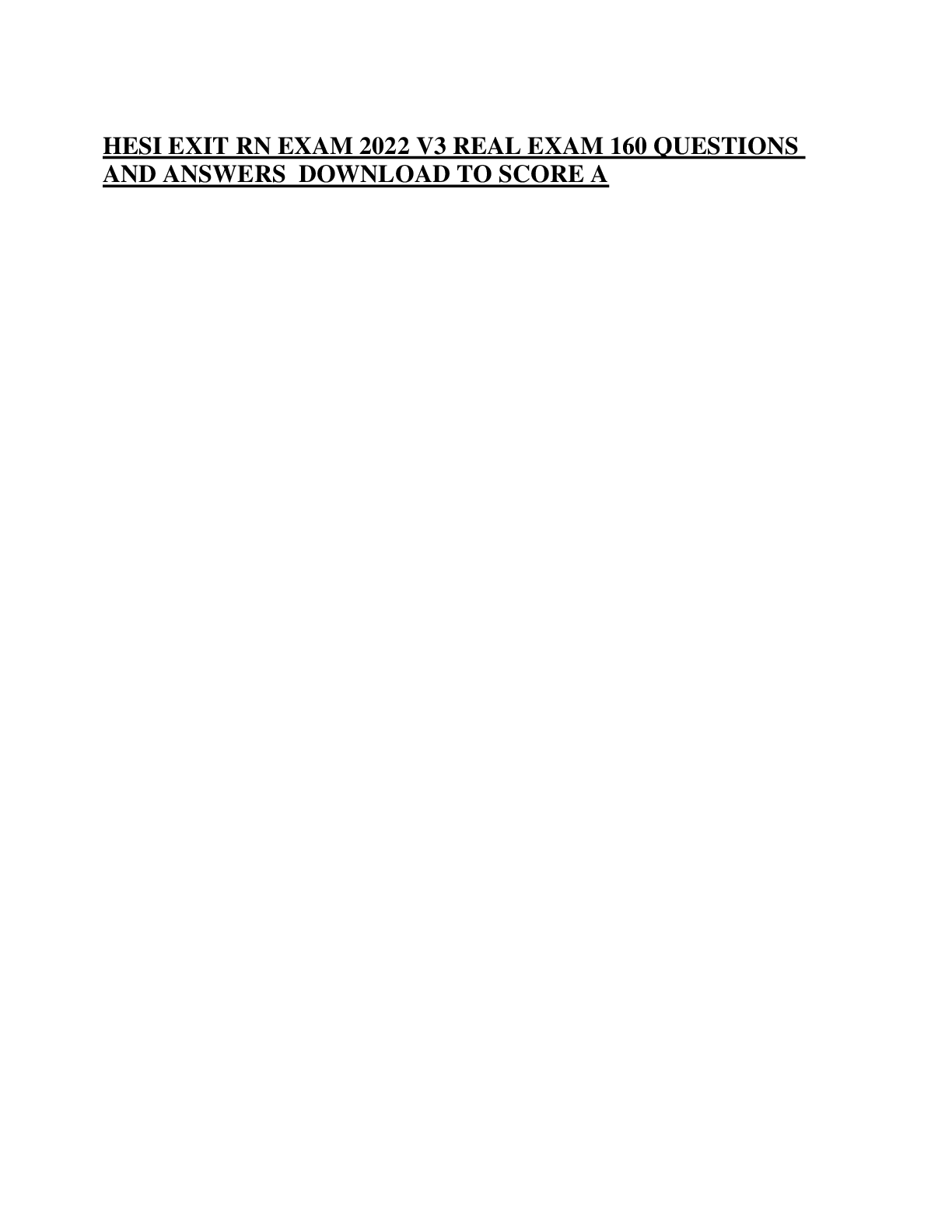
Reviews( 0 )
Document information
Connected school, study & course
About the document
Uploaded On
Jun 01, 2022
Number of pages
37
Written in
Additional information
This document has been written for:
Uploaded
Jun 01, 2022
Downloads
0
Views
49


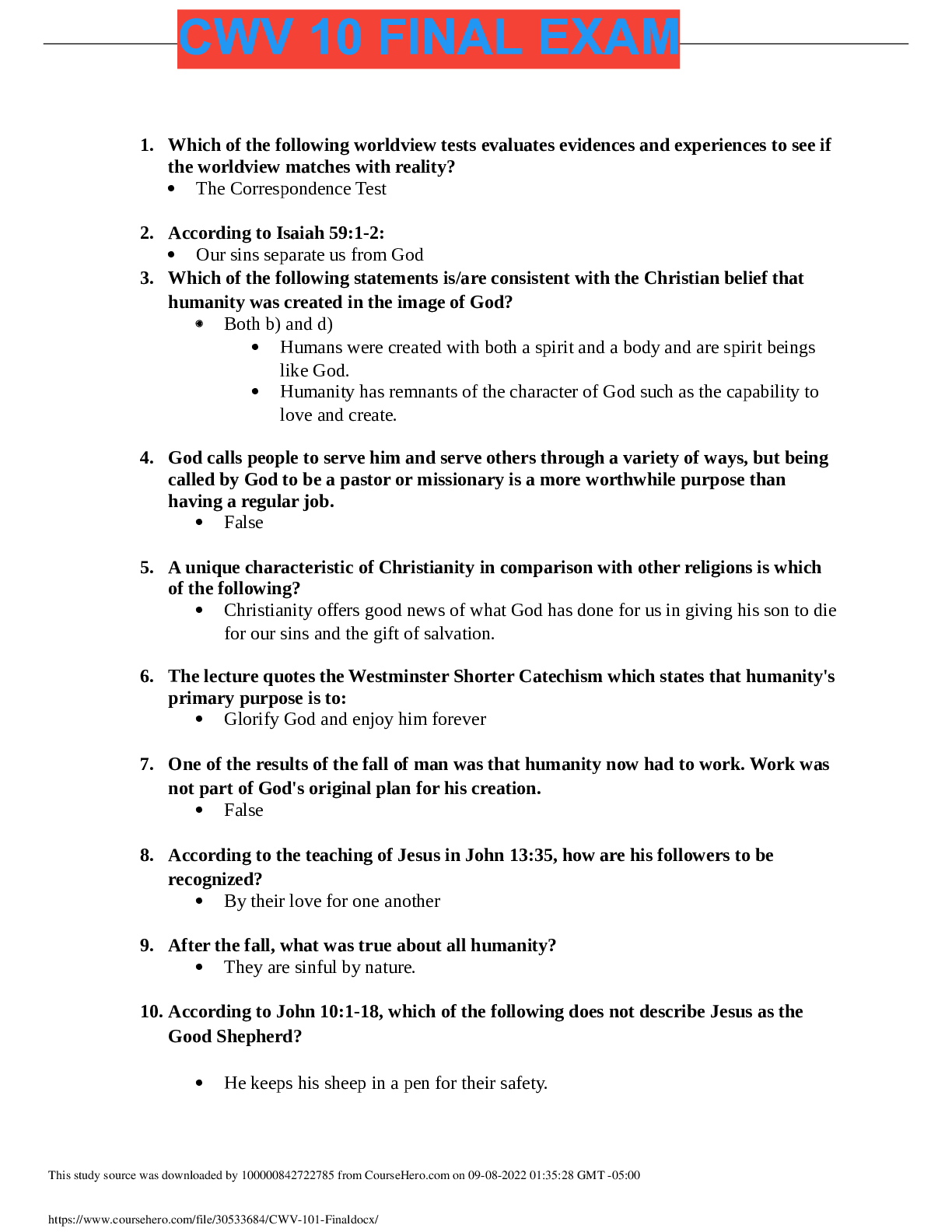

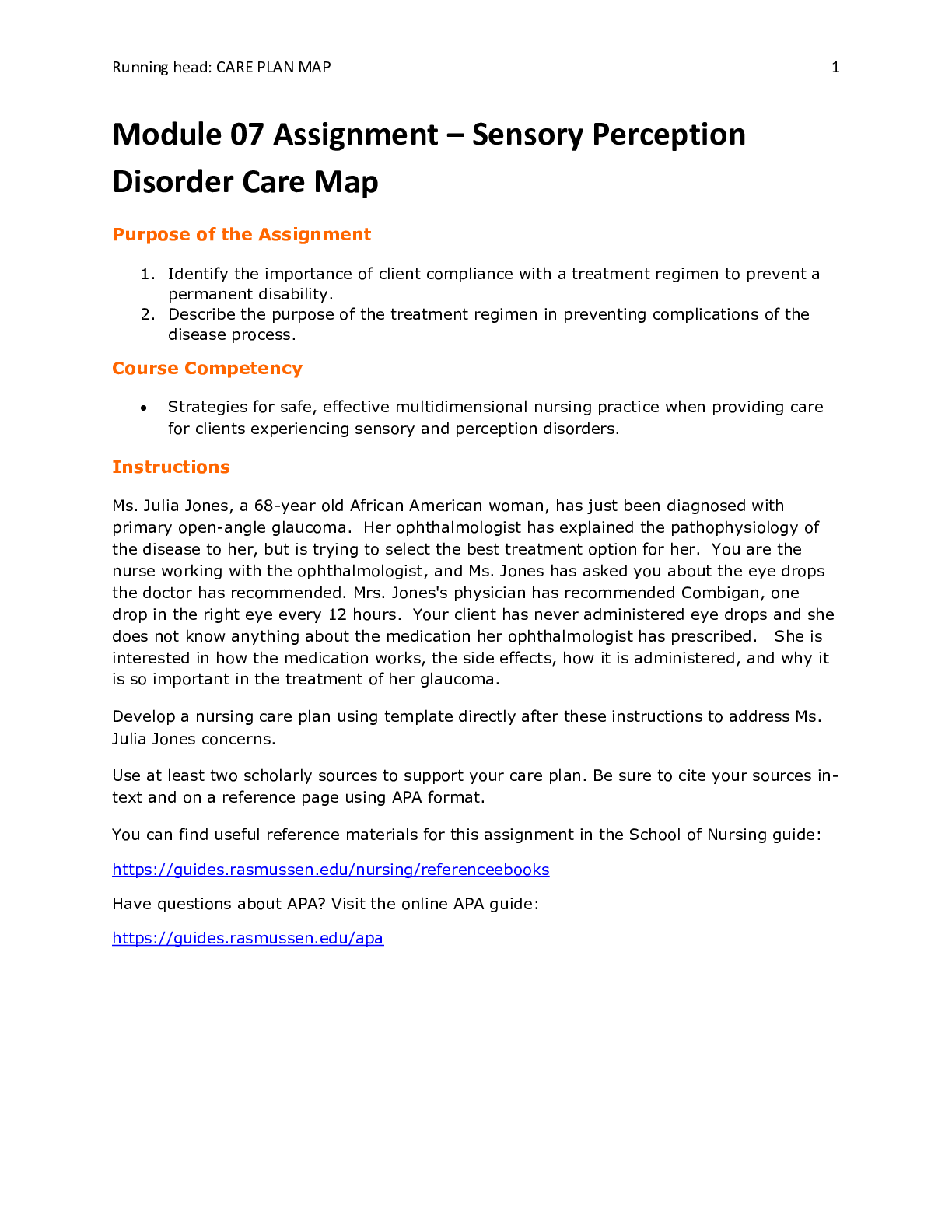
.png)


